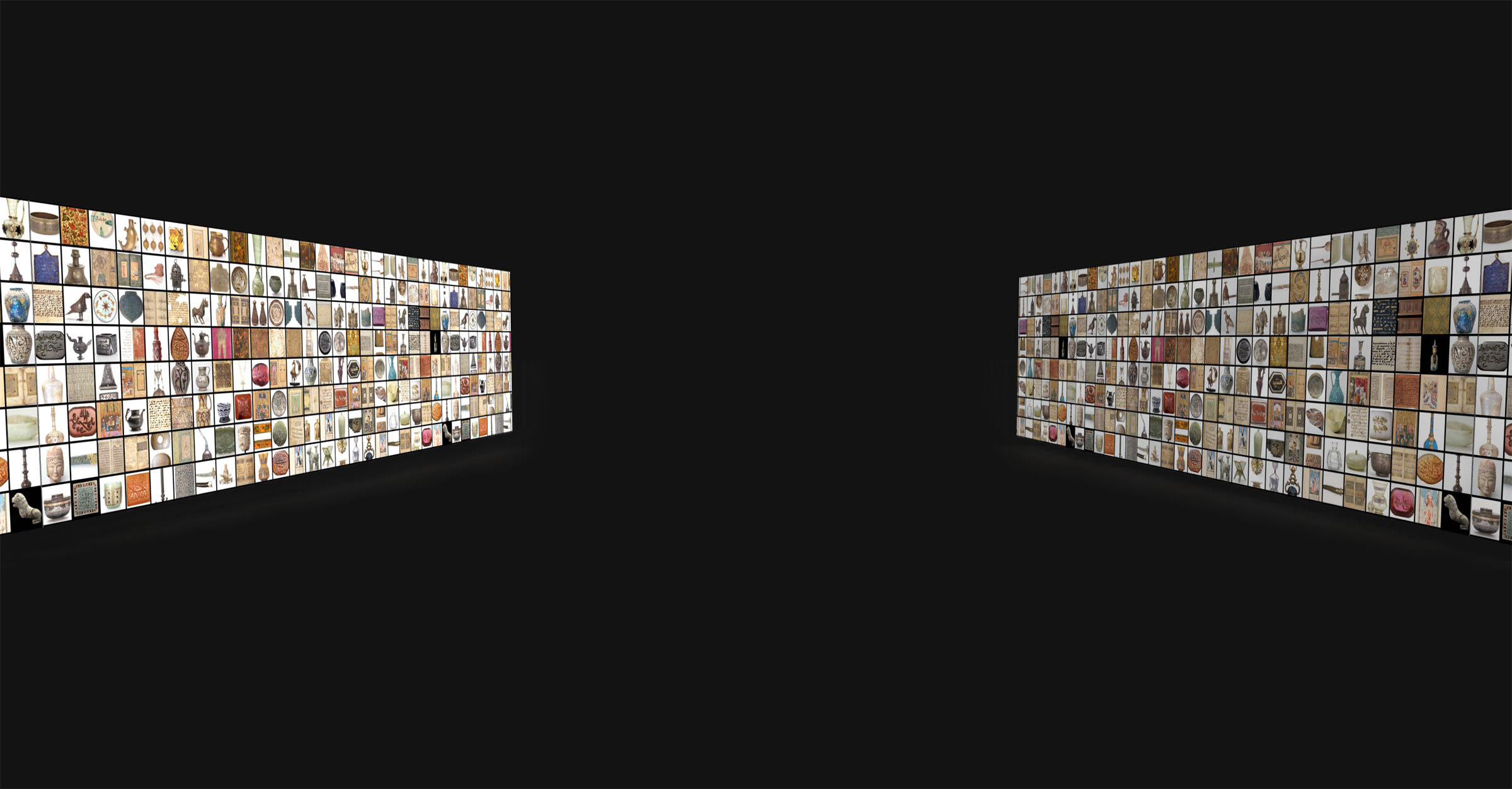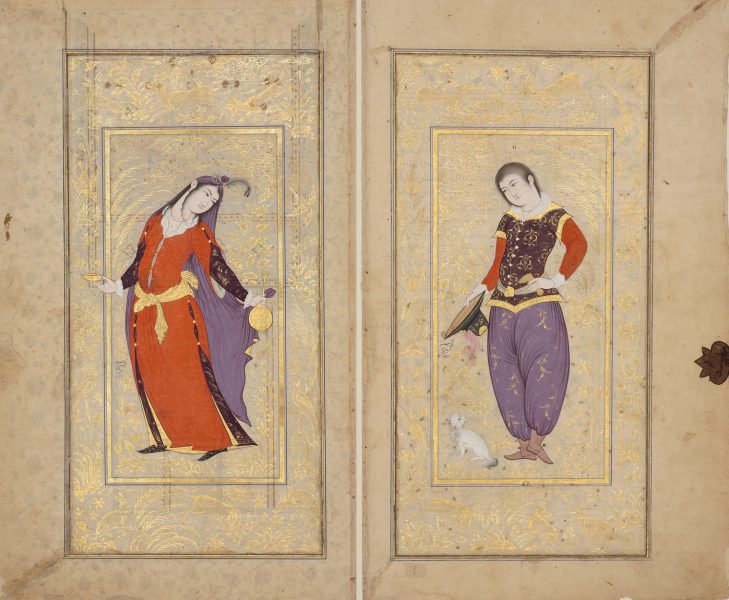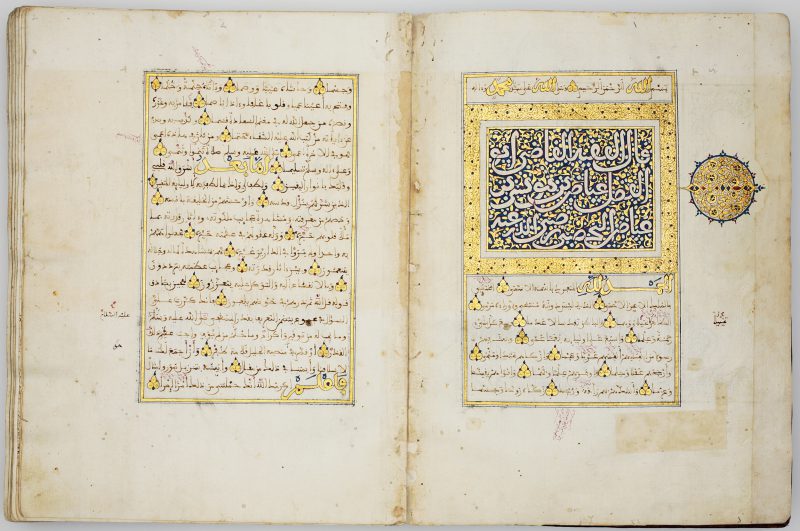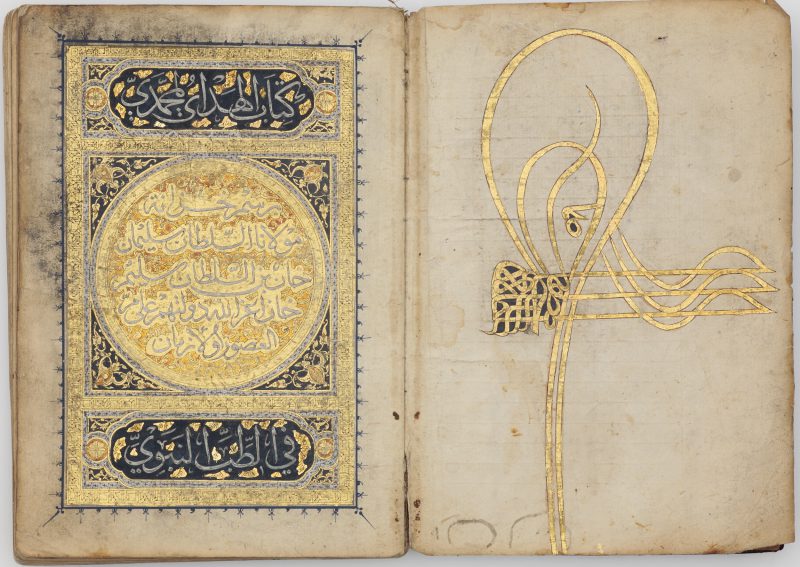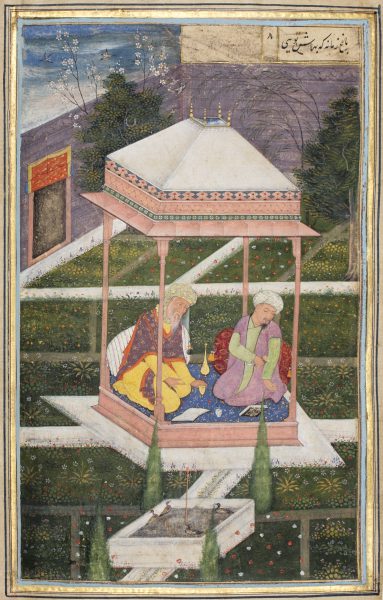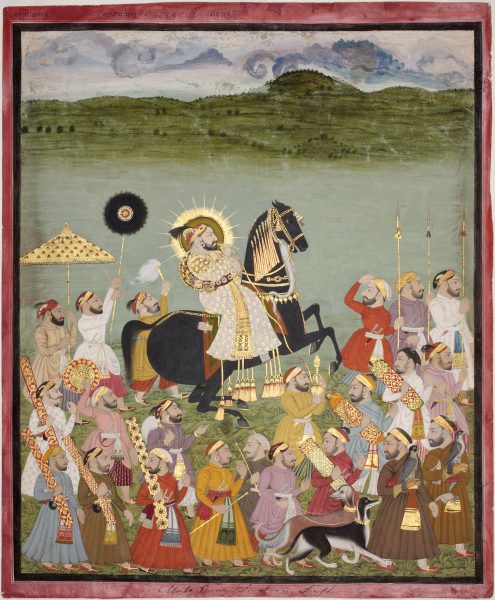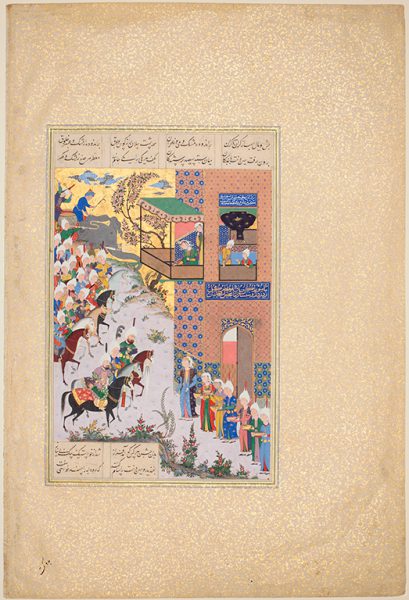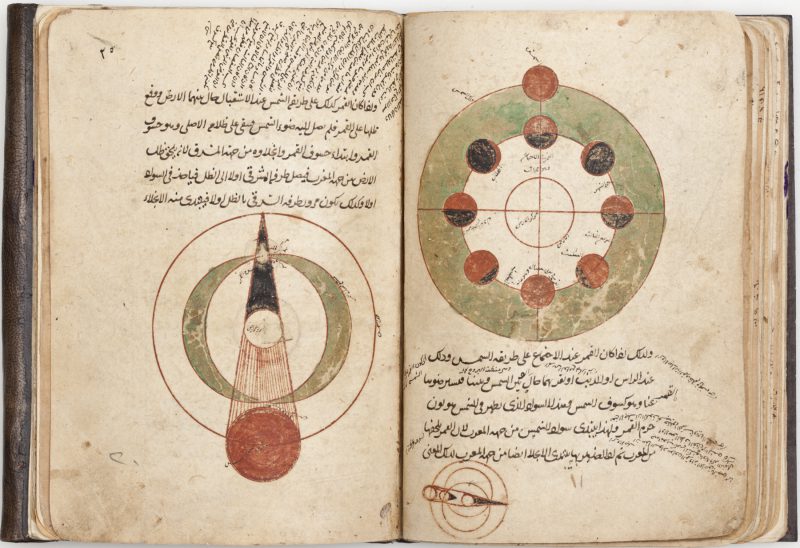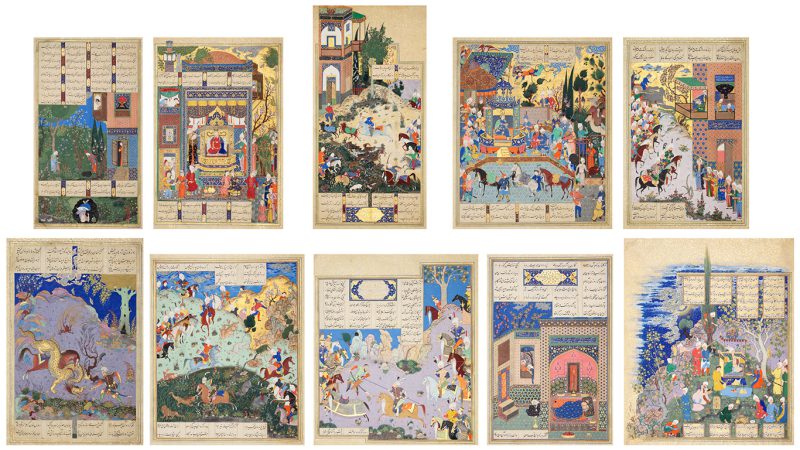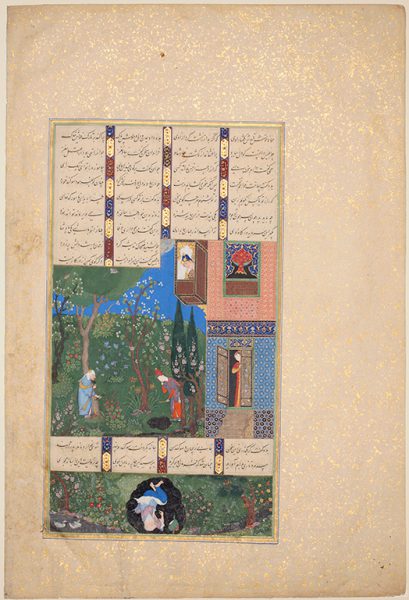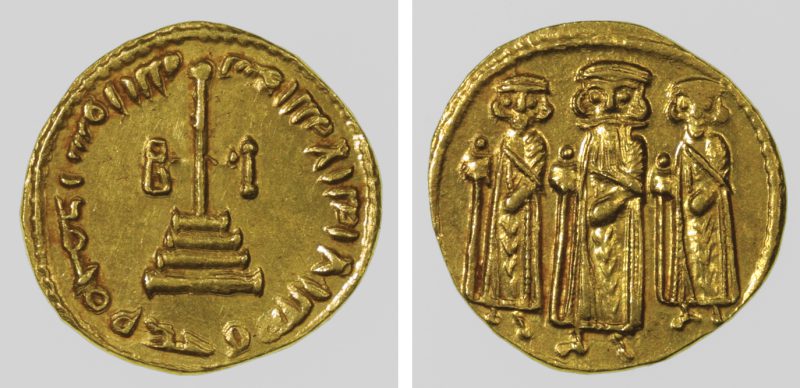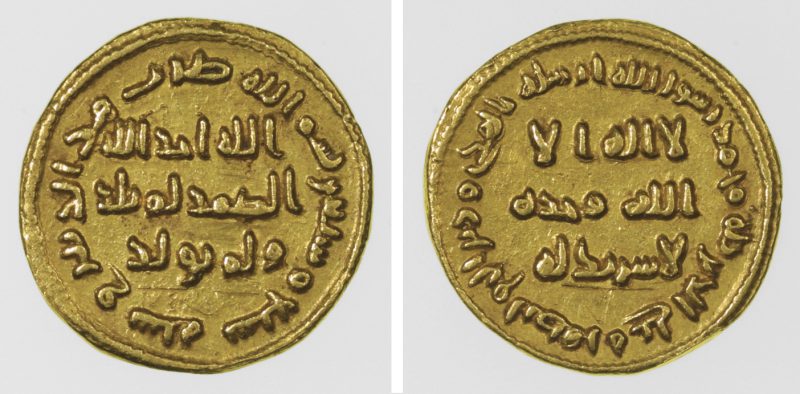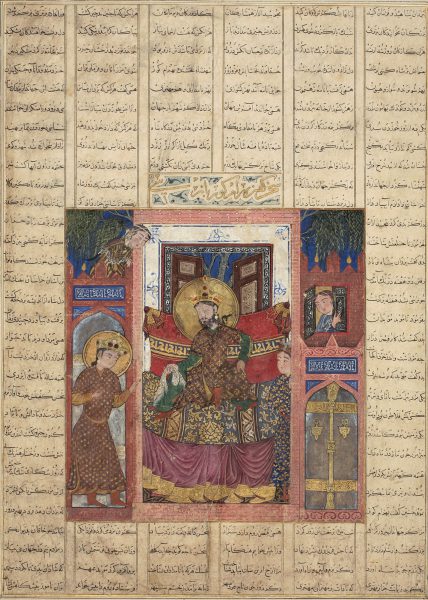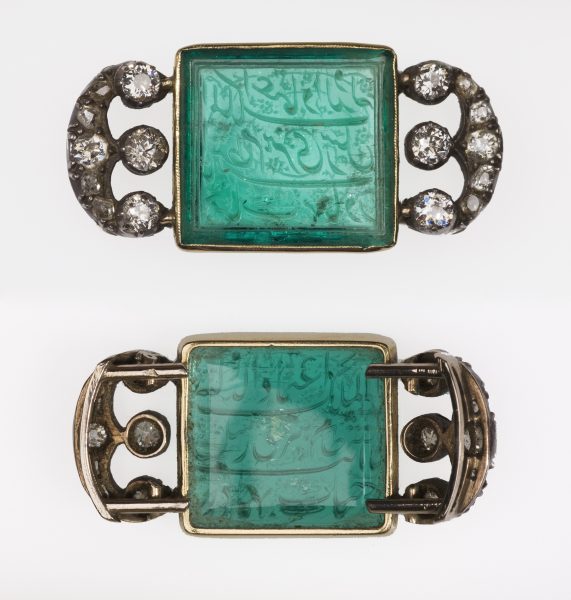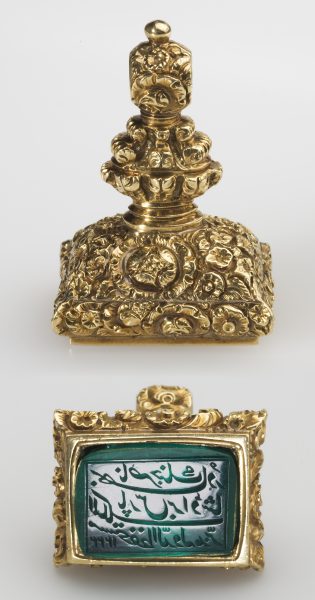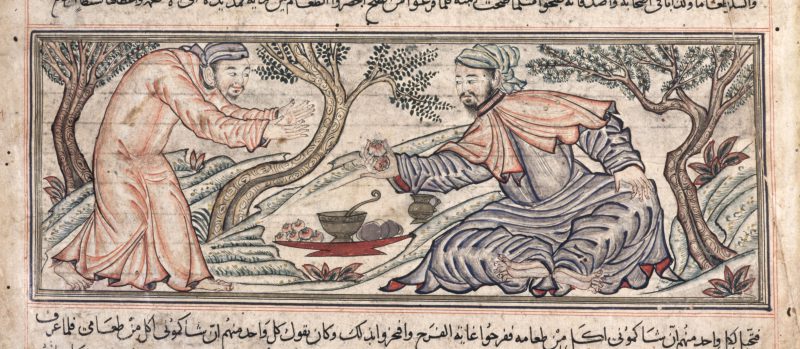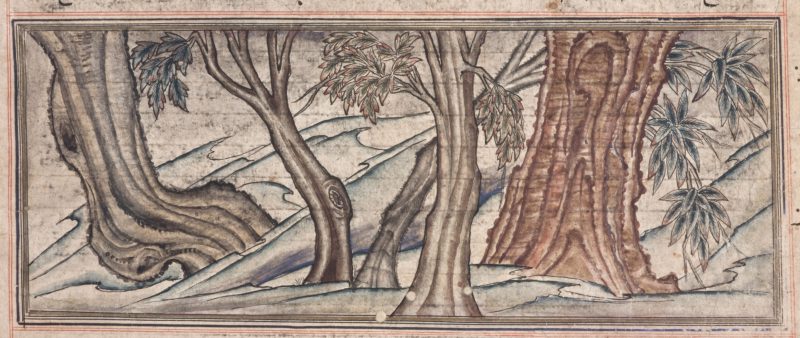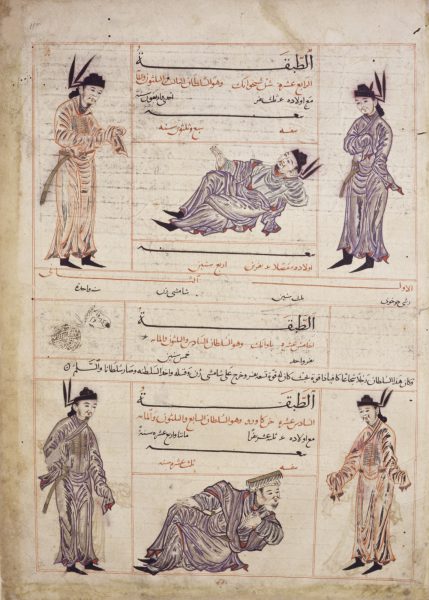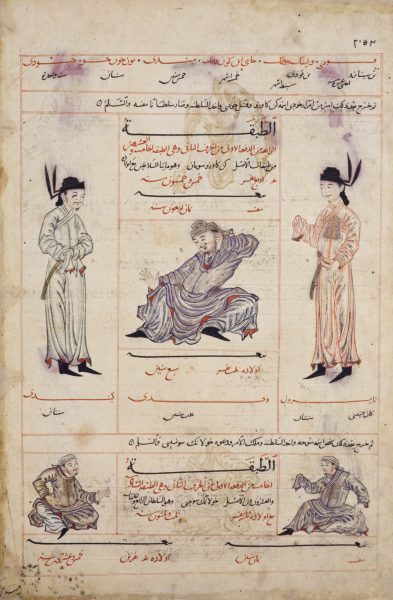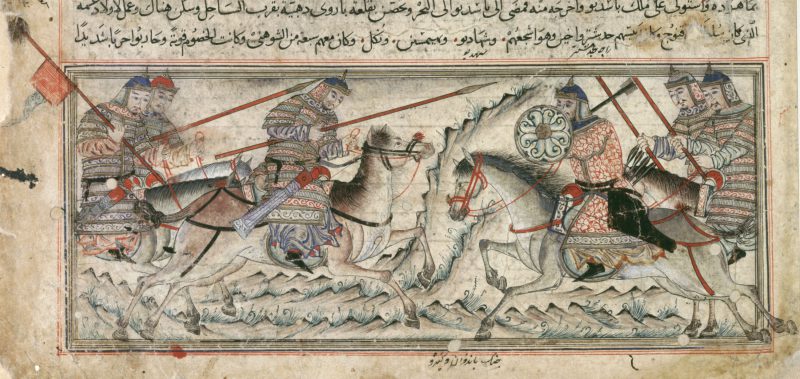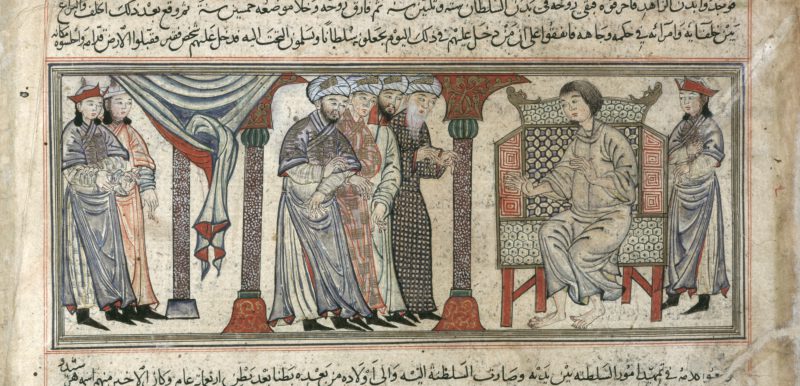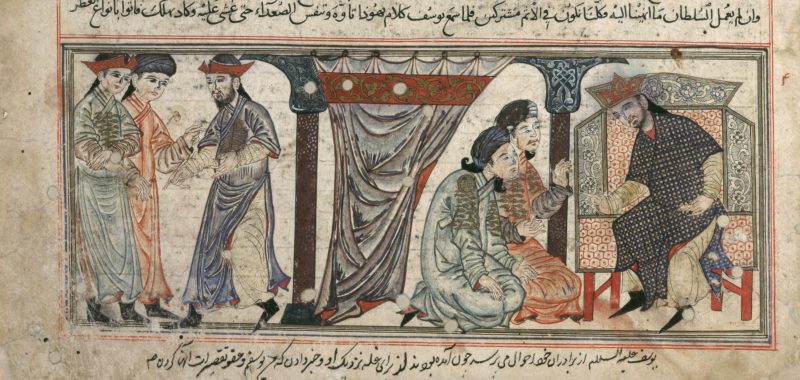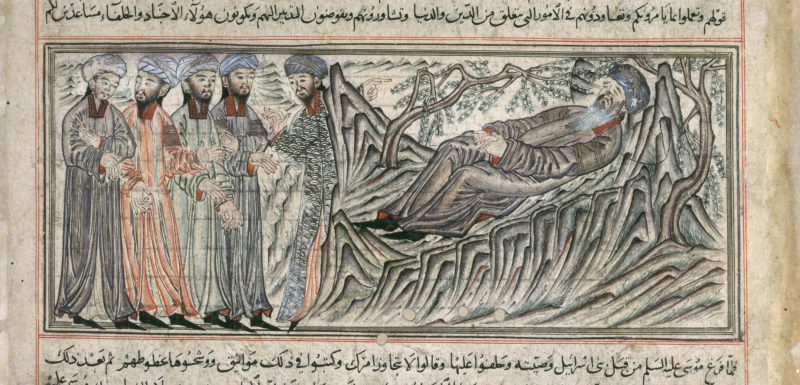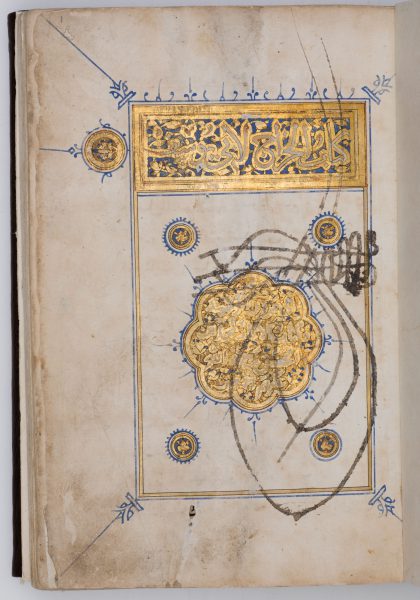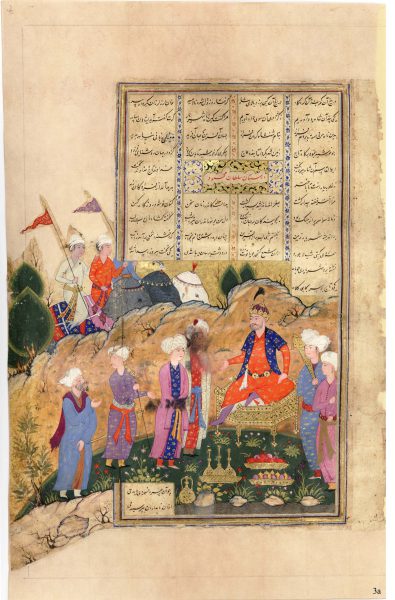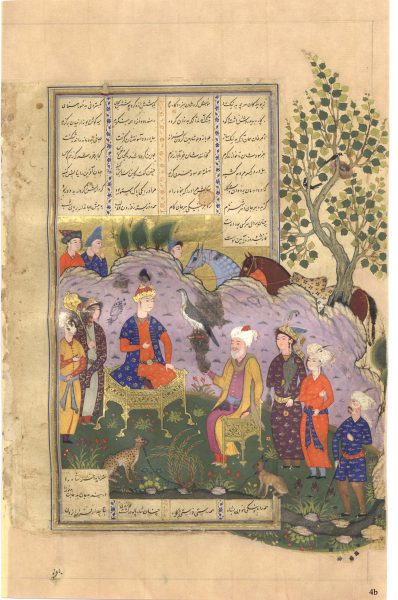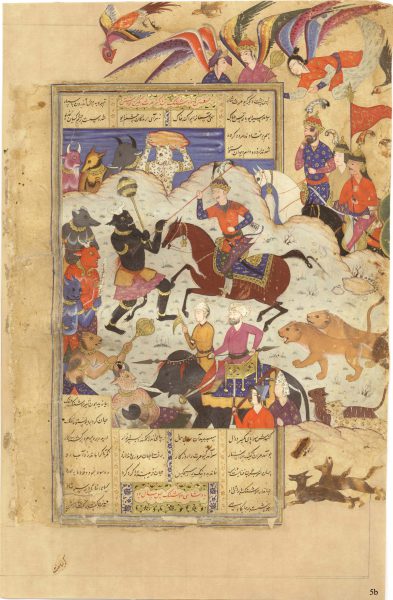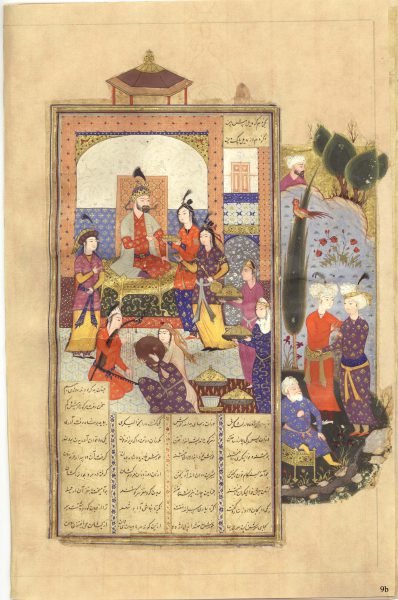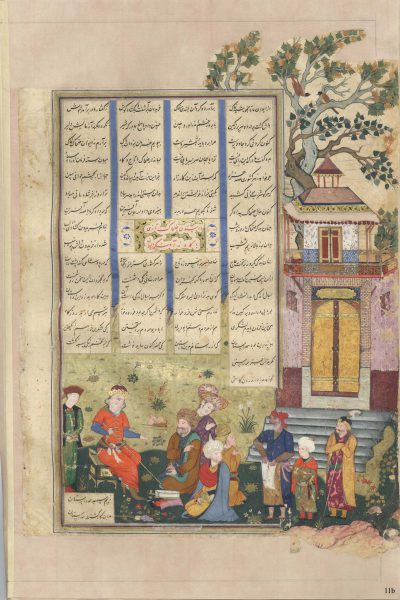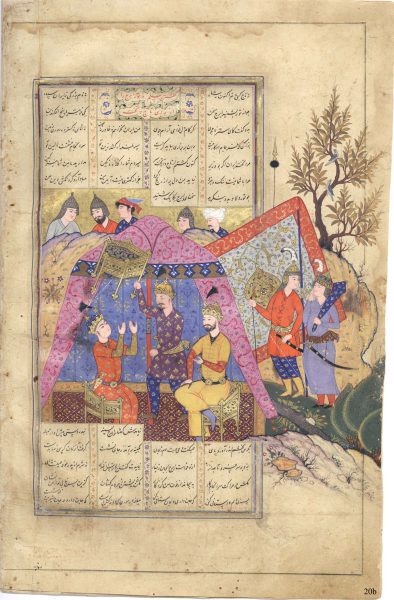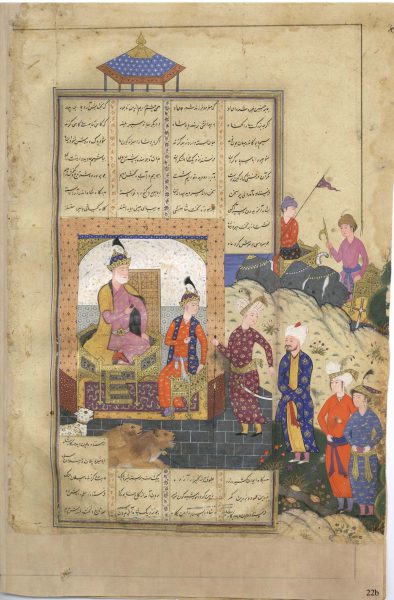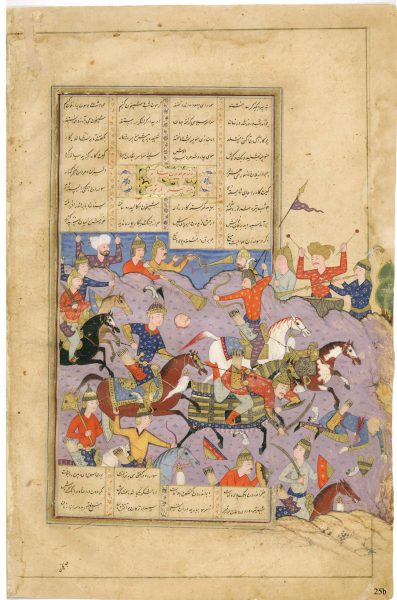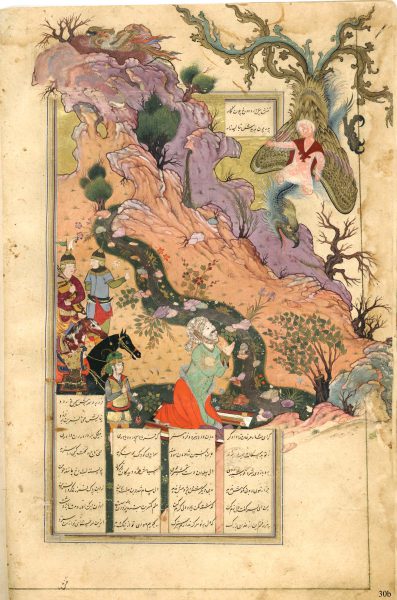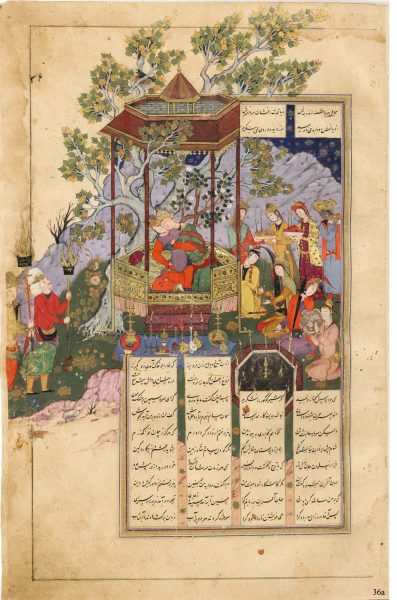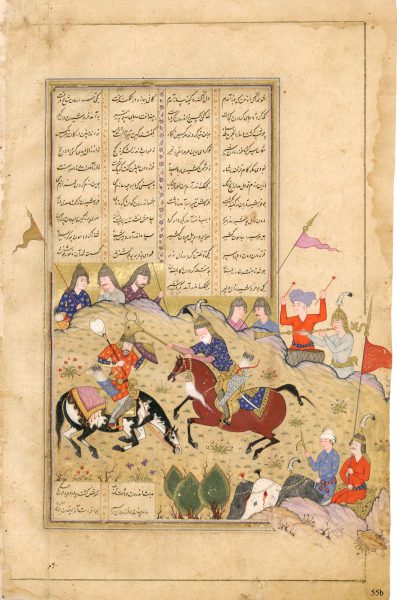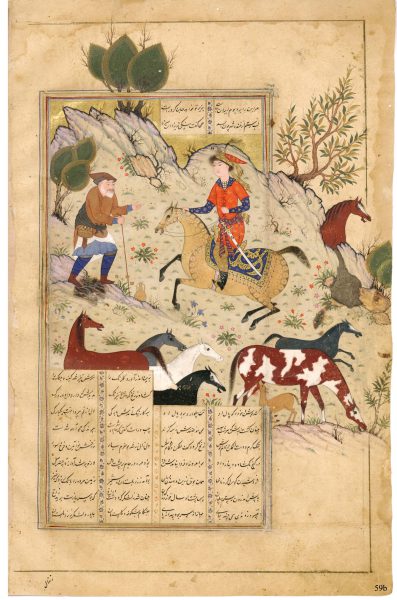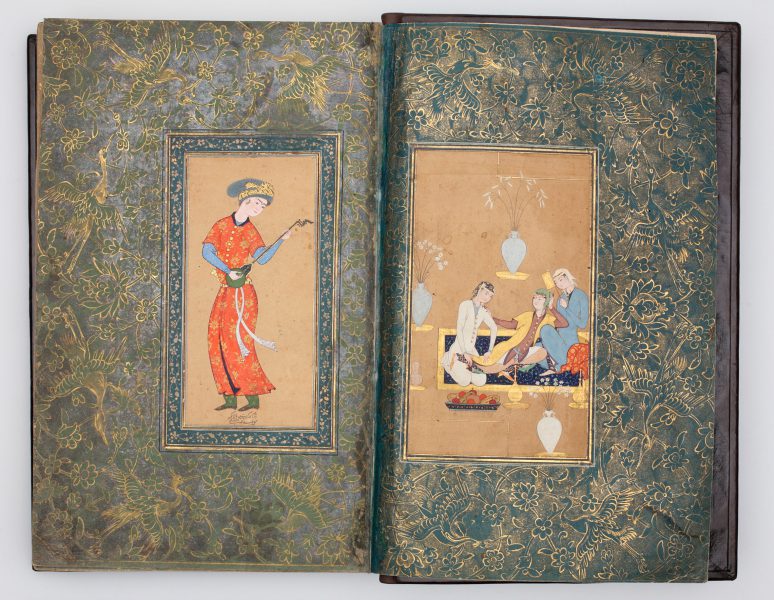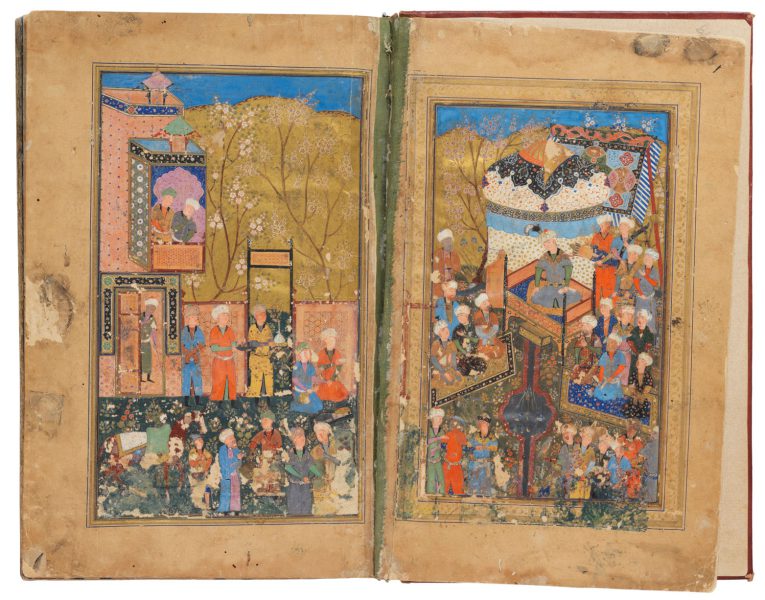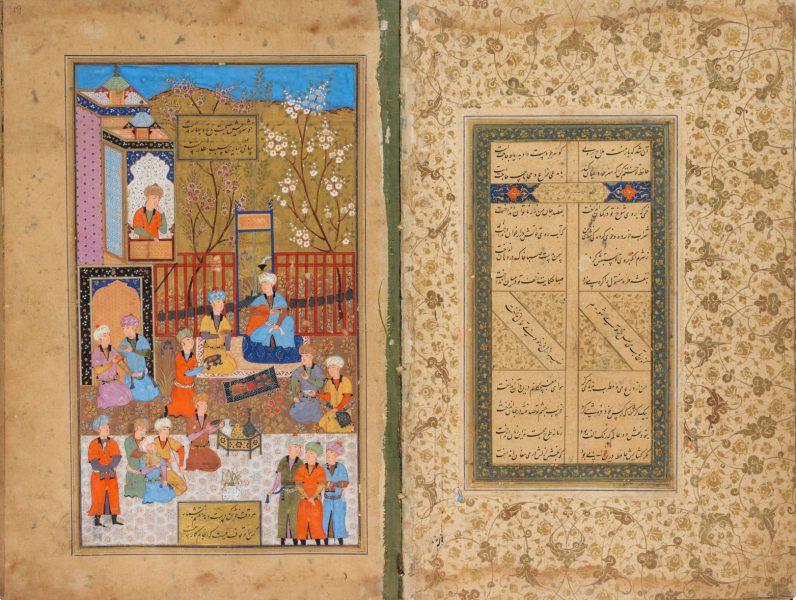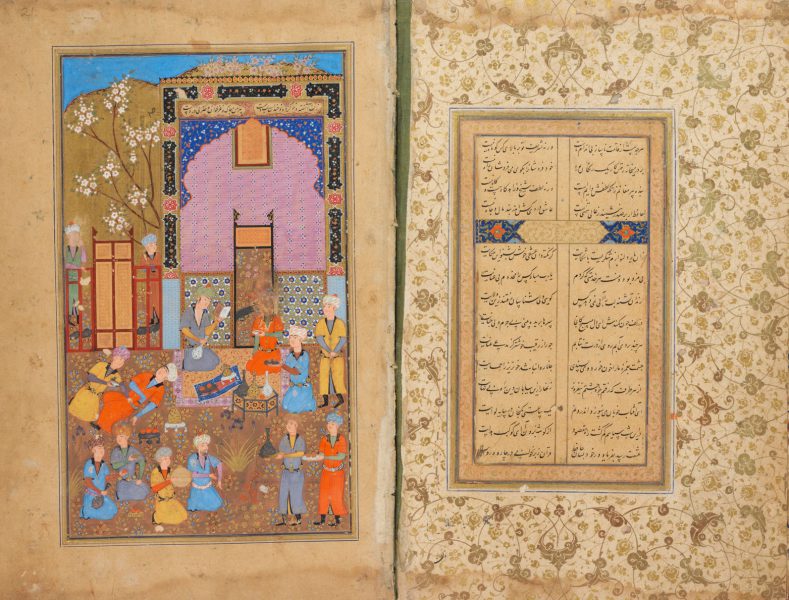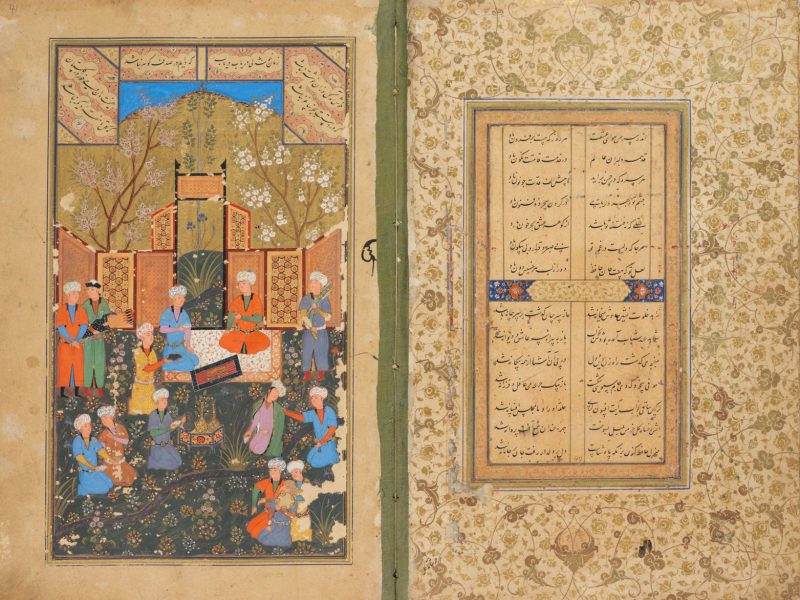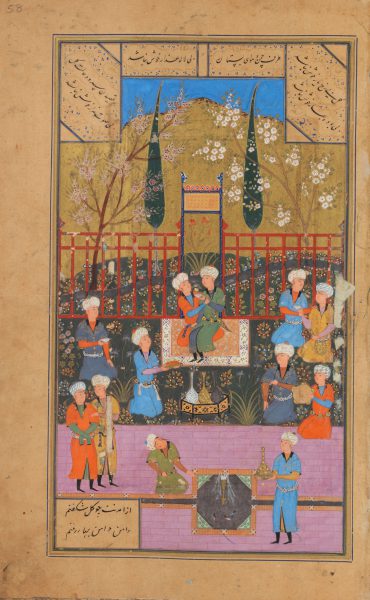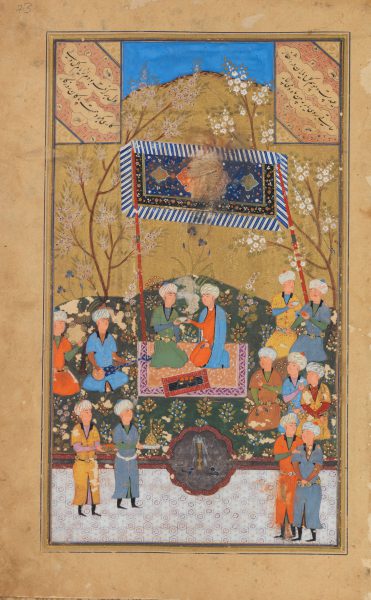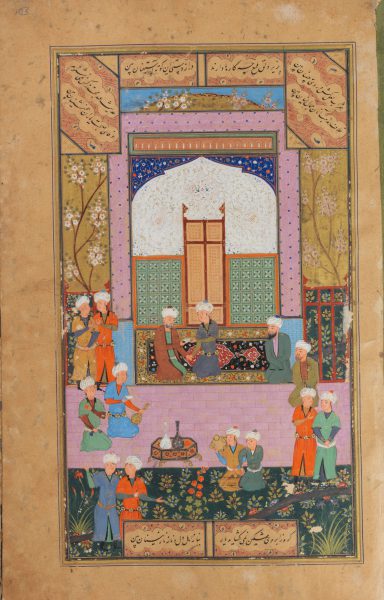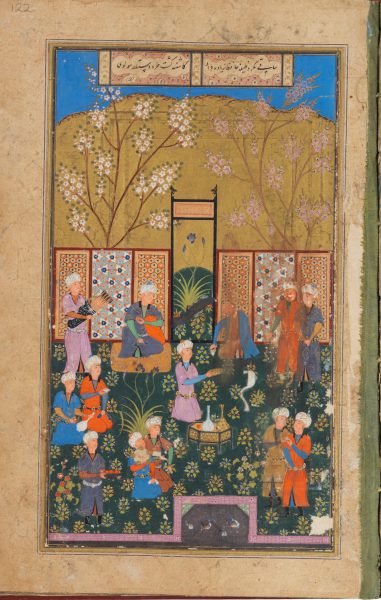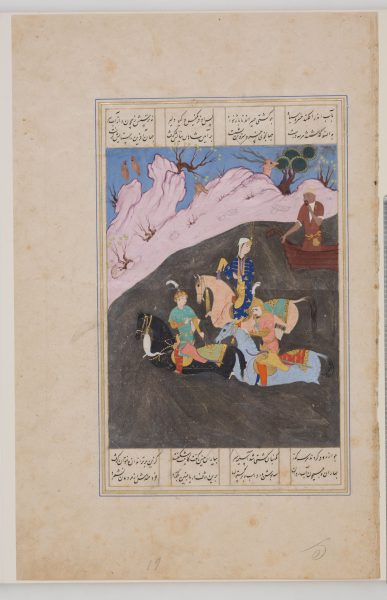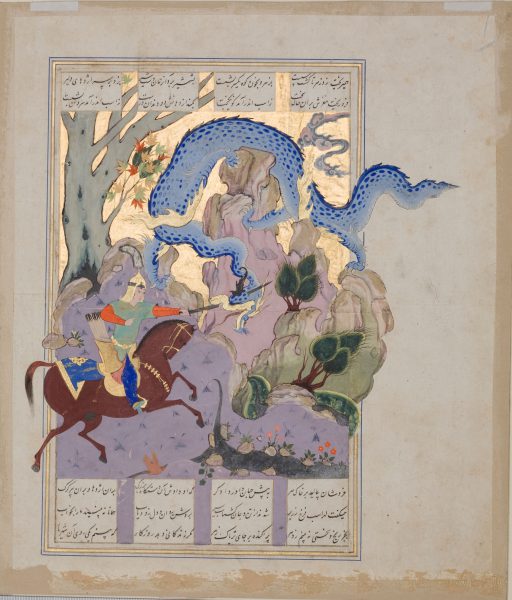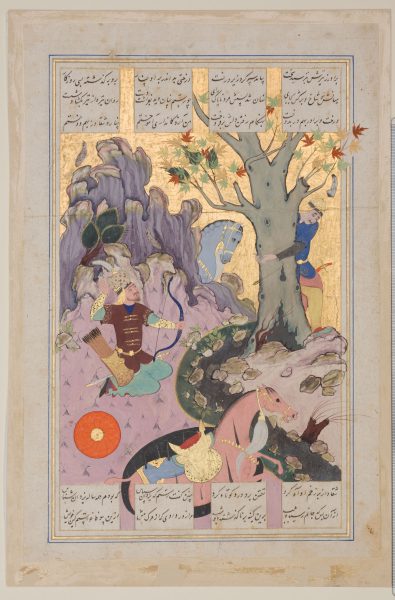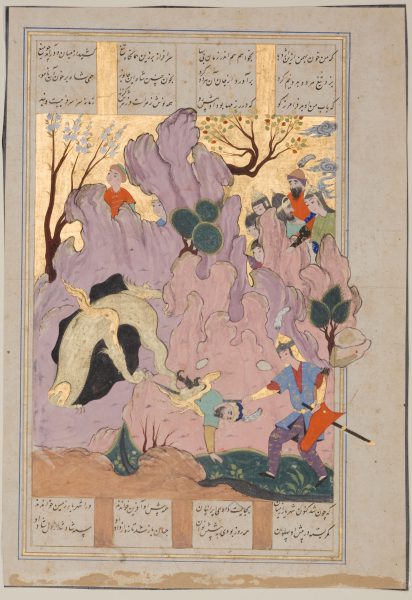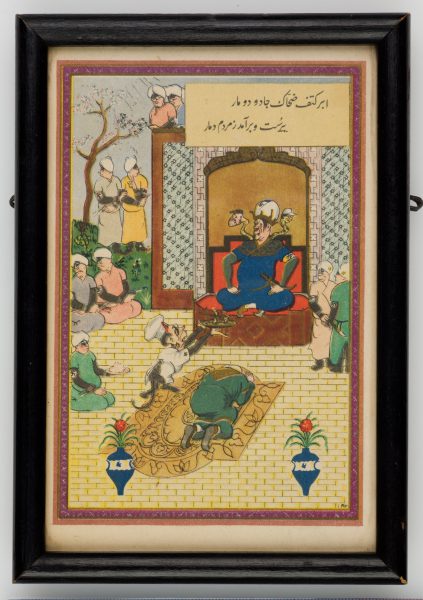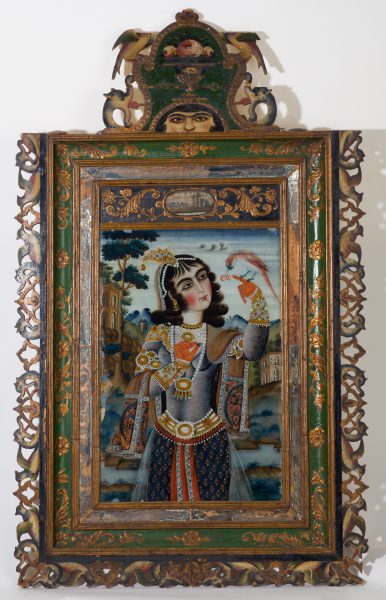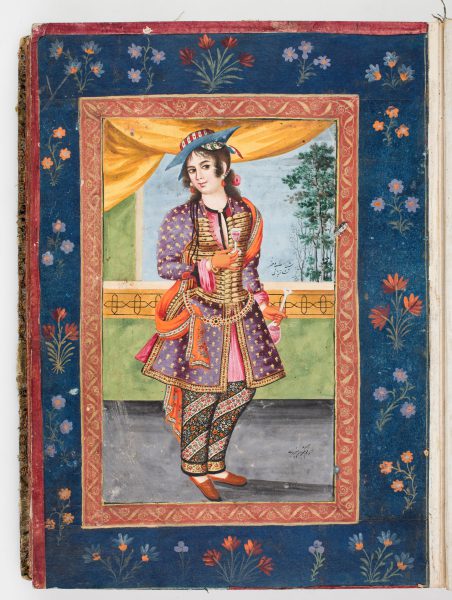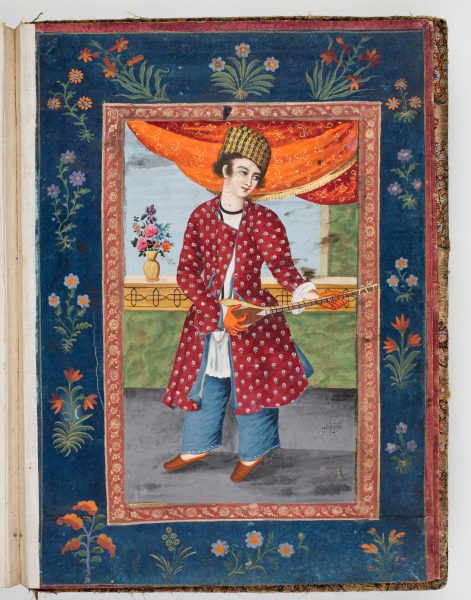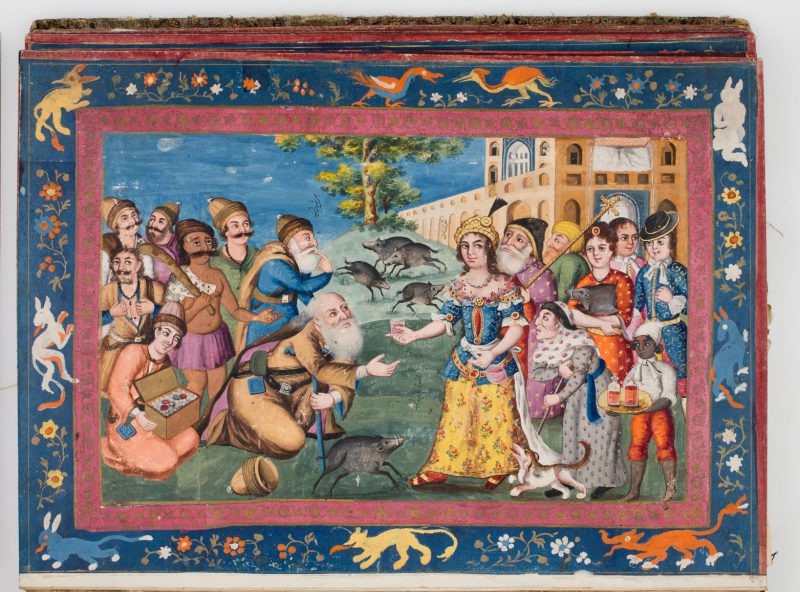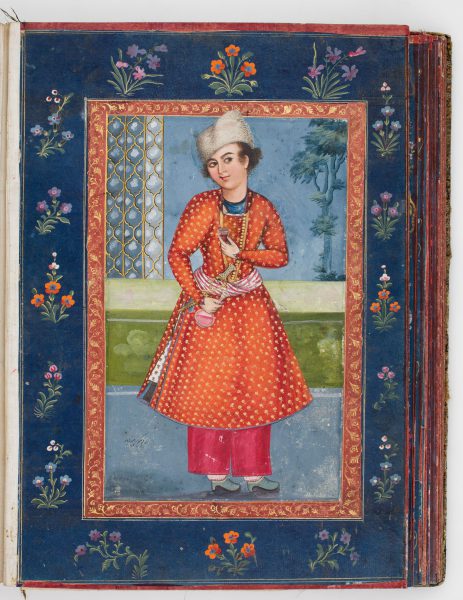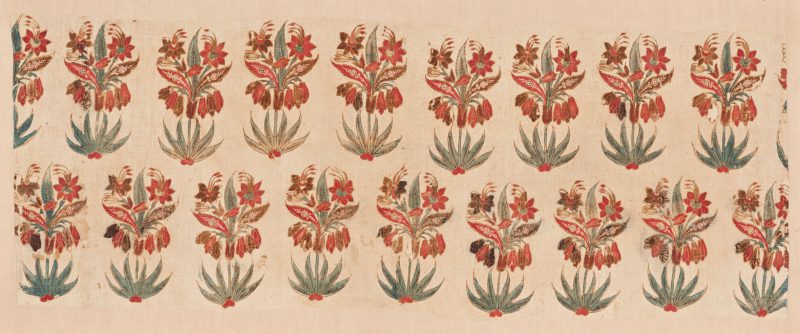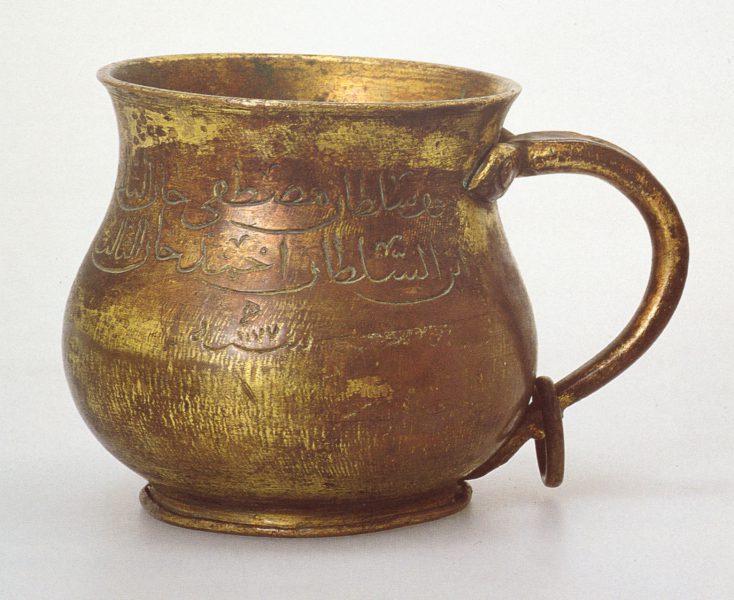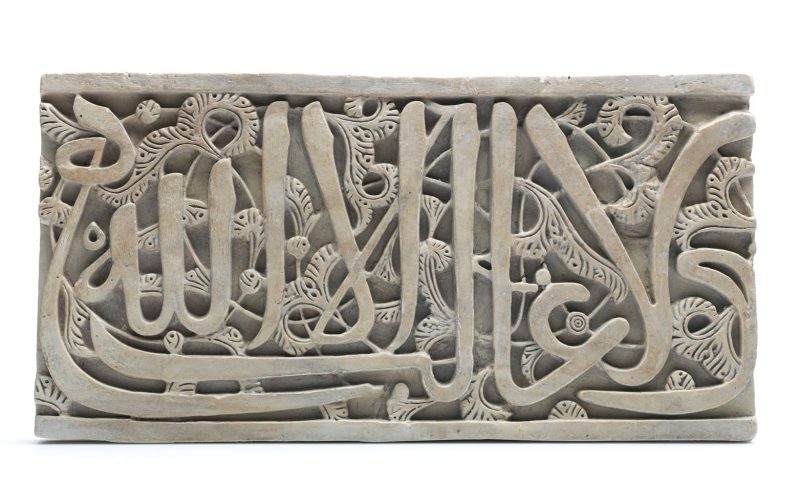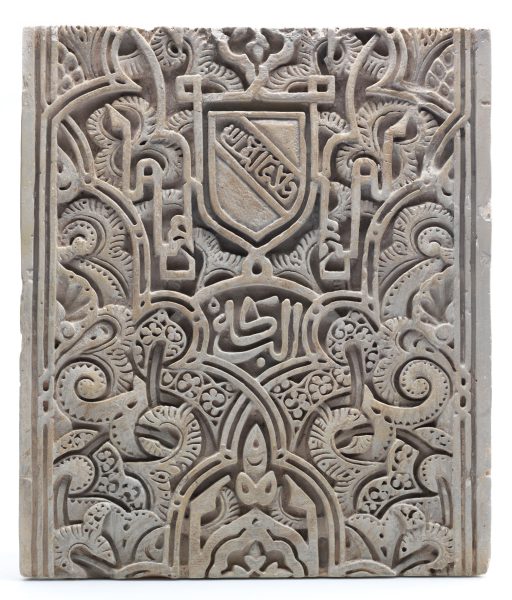Small Flask
JLY 1075
Jaipur, India
Youth in European Dress and Young Woman with Indian Headdress, from a Shahnamah
MSS 1000.1, MSS 1000.2
Isfahan, Iran
Calligraphic Composition
CAL 154
Ottoman Turkey
Mail and Plate Shirt
MTW 1158
Northern Caucasus
for the Persian or Ottoman market
Two ‘Hands of Fatimah’
JLY 1923
India, possibly Hyderabad (Deccan)
Calligraphic Practice Sheet
CAL 266
Qazvin, Iran
Single Folio from a Four-part Qur’an
KFQ 90
Iran, Isfahan
Carpet with Star Medallions
TXT 213
Ushak, western Anatolia, Turkey
Mosque Lamp
GLS 572
Egypt
Single Folio from a Qur’an
KFQ 45
Middle East or North Africa
Single Folio from a Qur’an
KFQ 50
Middle East
Five Folios from a Qur’an
KFQ 52
Middle East or North Africa
Two Folios from the ‘Blue Qur’an’
KFQ 53
North Africa or Spain
Single Folio from a Qur’an
KFQ 60
probably the Hijaz
Two Bifolios from a Qur’an
KFQ 82
Middle East
Single Folio from a Qur’an
KFQ 93
Middle East or North Africa
Single Folio from a Large Qur’an
KFQ 96
probably North Africa
Single Folio from a Qur'an
KFQ 34
Middle East
Single Folio from a Qur’an
KFQ 84
Middle East or North Africa
Single Folio from a Qur’an
KFQ 68
Middle East or North Africa
‘Miniature’ Single-volume Qur’an
QUR 430
Middle East
Bifolio from a Qur’an
KFQ 89
Middle East
Part 20 of a 30-part Qur’an
QUR 306
Middle East
Single Folio from a Qur’an
KFQ 78
Middle East
Single-volume Qur'an
QUR 284
Iraq
Fragment of Part 18 of a 60-part Qur’an
QUR 186
probably eastern Iran
QUR 497
Sinjar or Nisibin, northern Mesopotamia (the Jazirah)
Single-volume Qur’an
QUR 704
Iran or Iraq
Part One of a Royal Copy of al-Yahsubi’s Kitab al-Shifa’ bi-Ta‘rif Huquq al-Mustafa
MSS 359
Morocco, probably Fez
Album page in the Style of 'Muhammad Siyah Qalam'
MSS 1065
probably Tabriz, Iran
Album of Alphabetical Exercises (Murakkabat) by Mehmed Shevki
MSS 239
Ottoman Turkey
Album of Calligraphic Specimens
MSS 1073
India
Album of Calligraphy
MSS 28
Ottoman Turkey
Album Page with the Mughal Emperor Awrangzeb Out Hunting
MSS 1067
Mughal India
Al-Buni’s Shams al-Ma‘arif al-Kubra
MSS 556
Marrakesh, Morocco
Aquamanile in the Form of a Goose
MTW 846
Iran, Khurasan
Ardavan’s slave-girl Gulnar with the young Ardashir
MSS 1030, folio 516
Tabriz, Iran
Banner
TXT 224
Ottoman Turkey
Banner
TXT 239
Ottoman Turkey
Basin
MTW 1242
Iran, Khurasan
Belt Cup with Dragon Handle
MTW 1388
Golden Horde (South Russia or Central Asia)
Blue-and-white Bowl
POT 1910
Iran
Bowl with Notched Rim
POT 1578
Iraq
Bowl
JLY 1717
China or North India (bowl) and North India (decoration)
Large Bowl
POT 1623
Nishapur, Iran
Bowl
MTW 1313
Anatolia or Cilician Armenia
Bowl
POT 1173
Iran, Nishapur or the Caspian area (Mazandaran)
Bowl
POT 100
Nishapur, Iran
Bowl
POT 433
eastern Iran or Central Asia
Bowl
POT 1556
Nishapur, Iran
Bowl with a Lion Attacking a Fox
POT 1249
Syria
Bowl with Addorsed Birds
POT 1749
Syria
Bowl with a Benedictory Inscription
POT 98
Iran, perhaps Nishapur
Bowl with Inscription
POT 1492
Nishapur, Iran
Bowl with Inscription
POT 686
Afrasiyab (old Samarkand), Central Asia
Bowl with Inscription
POT 850
Nishapur, Iran
Bowl with Inscription
POT 1204
Nishapur, Iran
Bowl with Lustre Decoration
POT 1580
Iraq
Bowl with Quails
POT 1750
Syria
Bowl with the Figure of a Seated Prince
POT 99
Nishapur, Iran
Bracelet
JLY 1310
Eastern Iran, Khurasan
Broad-rimmed Dish with Splashed Decoration
POT 848
Nishapur, Iran
Calligraphic Composition
CAL 165
Ottoman Turkey
Camel-shaped Flask
GLS 598
probably Syria
Candlestick
MTW 1389
Anatolia
Candlestick
MTW 495
Egypt or Syria
Candlestick or Torch Stand
MTW 1283
Ottoman Turkey
Carved Finials
MXD 287
Iran
Casket
MTW 1266
Iran, Khurasan
Cenotaph
MXD 220
Iran, Caspian region
Central Section of a Banner
TXT 36
Ottoman Turkey
Chess Piece in the Form of a Seated Man
POT 1310
Kashan, Iran
Cockerel-headed Ewer
POT 855
Iran
Cornice Tile
POT 1532
Kashan, Iran
Court Lady with a Narcissus
MSS 1026
Mughal India
Crowned Head
MXD 325
Central Asia
Cup with Dragon Handle
MXD 57
perhaps Aqqoyunlu Tabriz, Iran
Cup-shaped Vessel
MTW 1376
Greater Iran or Afghanistan
Cylindrical Beaker with Lustre Decoration
GLS 438
probably Egypt
Dagger and Sheath
MTW 1135
India, Rajasthan or the Deccan
Dagger (Khanjar) and Sheath
MTW 1146
Mughal India or the Deccan
Dagger and Sheath
MTW 1383
Rajasthan, north India
Dagger and Sheath
MTW 1134
India or Afghanistan
Suspension Bracket
MTW 825
Mosul, Northern Iraq
Set of Calligraphers’ Tools
SCI 264
Ottoman Turkey
Dish
POT 1123
Iznik, Turkey
Dish
MTW 709
northern Iran
Dish with Lustre Decoration
POT 1593
Iraq
Dish with Moulded Decoration
POT 844
Iraq
Pair of ‘Door Handles’
MTW 1407, MTW 1428
northern Mesopotamia (now south-east Turkey)
Double Page from the Gulshan-i ‘Ishq of Nusrati
MSS 640.1-2
Hyderabad (the Deccan), India
Double-shelled Ewer
POT 773
Kashan, Iran
Drinking Vessel with dragon Handle
MTW 305
north-east Iran
Drinking Vessel with Dragon Handle
MTW 288
north-east Iran
Eight-pointed Star Tile
POT 509
Kashan, Iran
Elephant Aquamanile
POT 1285
Syria
Boat-shaped Cup
MTW 921
Sasanian Iran
Emerald-set Box
JLY 1857
Mughal India
Emerald Pendant
JLY 1856
Mughal India
Ewer
MTW 1549
Iran, Khurasan
Ewer in the Shape of a Goose or Swan
MTW 1533
Mughal India or the Deccan
Falcons’ Hoods
MXD 282
India
Figurine of a Dromedary
POT 857
Kashan, Iran
Finial
JLY 1073
Jaipur, India
Flintlock Gun
MTW 1165
Ottoman Turkey
Enamelled Flask
GLS 350
Syria
Flask
GLS 172
Syria or Egypt
Bell-shaped Flask
GLS 333
Iran or Egypt
Flask
POT 1584
Iznik, Turkey
Flask (Surahi)
JLY 1803
Jaipur, Rajasthan, India
Flask with Facet-cut Decoration
GLS 178
Iran or Iraq
Flask with Standing Figures
POT 107
Iran, perhaps Nishapur
Flat-woven Carpet (Kilim)
TXT 189
Turkey or Iran
Flintlock Gun
MTW 1166
Ottoman Turkey
Floral Carpet
TXT 191
Iran, probably Kirman
Folding Backgammon Board
LAQ 284
Iran
Footed Beaker
GLS 351
Iran or Egypt
Footed Cup with Lustre Decoration
GLS 594
probably Egypt
Footed Dish
JLY 1076
Mughal India
Footed Dish with an Advancing Lion
MTW 1575
Sasanian Iran
Footed Jug
GLS 442
Iran or Iraq
Footed Pouring Vessel or Kettle Ewer
MTW 634
Iran
Four Tiles from a Frieze
POT 1728
Ottoman provinces, Syria or Palestine
Four Wooden Roundels
MXD 265
Ottoman Turkey
Fragment of a Silk Robe
TXT 245
Central Asia or Iran
Frieze Tile with a Dragon
POT 790
Kashan, Iran
Frieze Tile with Inscription
POT 1677
Kashan, Iran
Small Box in the Form of a Mango
JLY 2148
Northern India
Hanging
TXT 23
Nasrid Spain,probably Granada
Helmet in the Form of a Turban
MTW 1442
India, the Deccan
Hemispherical Basin
MTW 925
Greater Iran, Khurasan or Afghanistan
Hemispherical Basin
MTW 924
Greater Iran, Khurasan or Afghanistan
Hexagonal Table or Stand
POT 1700
Syria
Hookah
JLY 1974
Mewar (Rajasthan), India
Hookah Base in the Shape of a Dolphin
MTW 1500
Mughal India
Human-headed Jug
POT 1834
Eastern Iran or Central Asia
Incense Burner
MTW 1545
Spain
Incense Burner
MTW 1044
Syria
Incense Burner
MTW 1417
Iran, Khurasan
Incense Burner in the Form of a Dove
MTW 100
Iran, Khurasan
Incense Burner in the Form of a Lynx
MTW 412
Iran, Khurasan
Incense Burner in the Form of an Elephant
MTW 1041
eastern Iran or northern India
Incense Burner or Pomander in the Form of a Lynx
MTW 1525
Iran
Inkwell
MXD 56
Middle East
Instrument Case with Shuttered Mirror
LAQ 11
Isfahan, Iran
Jar
POT 1347
Egypt or Syria
Judith with the Severed Head of Holofernes
MSS 1005
Isfahan, Iran
Jug with Lustre Decoration
POT 101
Iraq
Kitab al-Hadi al-Muhammadi fi’l-Tibb al-Nabawi (a Treatise on Prophetic Medicine)
MSS 568
probably Damascus
Knife
MTW 1492
Ottoman Turkey
Pen Box
LAQ 1
Isfahan, Iran
Lady Proffering a Hookah
MSS 999
Isfahan, Iran
Lamp or Candlestick
MTW 1531
Iran or Central Asia
Large Aquamanile or Table Fountain in the Form of a Feline
POT 941
Iran or Afghanistan
Large Ewer
MTW 1584
India, probably the Deccan
A Khamsah of Nizami for Prince Awrangzeb
MSS 1023
possibly Iran (text); Mughal India (illustrations)
Jar with Lid
JLY 1804
possibly Khotan (jar and lid) and North India (mounts)
Long-necked Flask
GLS 330
Iran
Mace
MTW 1490
Ottoman Turkey
Magic Bowl
MTW 1444
India, the Deccan
Maharana Sangram Singh of Mewar out Hunting on his Horse, Jambudvipa
MSS 965
Udaipur, Rajasthan, India
A Male Comb Duck
MSS 894
Company school, India
Medallion
GLS 608
Iran, Afghanistan or Central Asia
Medallion Carpet
TXT 220
Iran, perhaps Kashan
Mirror Case with Hinged Shutter
LAQ 42
Isfahan, Iran
Mother-of-pearl-inlaid Casket
MXD 255
Gujarat, India
Narrow-necked Flask
POT 1320
Iran
Necklace
JLY 1261
South India, probably Tamil Nadu
Niche Rug
TXT 198
Istanbul, Turkey, or Ottoman Cairo, Egypt
Niche Rug
TXT 236
probably Central Iran (Qazvin, Qum, Isfahan or Kashan)
Niche Rug with Floral Field
TXT 186
Cairo, Egypt (Ottoman court manufactury)
Oil Lamp
MTW 1293
Iran or Anatolia
Order of the Lion and the Sun
JLY 1631
Tehran, Iran
Pair of Anklets
JLY 1107
Benares (Varanasi), India
Pair of Anklets
JLY 1916
Sind
Pair of Door-knockers
MTW 1585
Egypt or Syria
Pair of Dragon-headed Candlesticks
MTW 1528
Khurasan, perhaps Herat, or Central Asia
Pair of earrings
JLY 2149
Egypt or Syria
Pair of Earrings with Pendant Chains
JLY 752
Iran
Pair of Fly-whisk Handles
JLY 1858
India, Rajasthan, probably Jaipur
Pair of lamp stands
MTW 1527
India
Pair of Stirrups
MTW 1512
probably Ghaznavid
Rectangular Pan Box
JLY 1719
Mughal India
Pan Box and Tray
JLY 1720
Mughal India
Panel with the Single Name, Allah, Repeated
TXT 222
probably North Africa
Pen Box
LAQ 133
India or Iran
Pen Box
LAQ 39
Isfahan, Iran
Pendant in the Form of an Eagle Displayed
JLY 2151
Deccan or Southern India
Pestle and Mortar
MTW 1354, MTW 688
Iran, Khurasan
Pair of Pierced Tiles
POT 1885
Syria
‘Pilgrim Flask’
MTW 1530
Mughal India or the Deccan
Plaque, Probably from a Belt
JLY 1286
Southern Spain
Plate
GLS 601
probably Syria
Portrait Miniature of the Qajar Ruler, Fath ‘Ali Shah
JLY 1231
Iran
Pouring Vessel in the Form of a Bird
MTW 1430
Iran, Khurasan
Powder Measure
MTW 1431
India
Pyriform Flask
GLS 611
probably Iran
Casket with the Remains of a Combination Lock
MTW 850
Jazira, northern Iraq
Rectangular Tray
MTW 1363
Iran, Khurasan
Ring
JLY 1109
South India, possibly Mysore
Rustam and the Seven Warriors at the hunting-ground of Afrasiyab
MSS 1030, folio 135
Tabriz, Iran
Rustam slays a dragon
MSS 1030, folio 119
Tabriz, Iran
Sabre hilt
MTW 1142
India
Seal of Shah Tahmasp
TLS 2714
Qazvin, Iran
Seal Ring with Tall Bezel
JLY 236
Iran
Section from a Chasuble
TXT 129
Bursa, Turkey
Set of 16 Gaming Pieces
JLY 1129
Mughal India
Set of Saddle Plaques
MTW 1560
Central Asia
Set of Six Buttons
JLY 1225
Southern Spain
Shah Jahan Watches an Elephant Fight, from the Padshahnamah
MSS 900
Mughal India
Shallow Bowl
POT 389
Nishapur, Iran
Shallow Bowl with Lustre Decoration
POT 1686
Iraq
Shallow Dish with Lustre Decoration
GLS 614
probably Egypt
Shallow Dish with Four Figures
POT 491
Kashan, Iran
Silk Brocade
TXT 150
Iran, or perhaps Turkey
Silk Lampas
TXT 170
Bursa, Turkey
Silk Rug
TXT 93
Mughal India
Silk Textile
TXT 237
Iran
Drinking Vessel
MTW 312
Ottoman Turkey, Anatolia or the Balkans
Silver-gilt Filigree Cabinet
MTW 1583
Goa, India
Mihrab’s wife, Sindukht, comes out with slaves carrying gifts to welcome Sam
MSS 1030, folio 89b
Tabriz, Iran
Single-volume Qur'an
QUR 614
India, probably Saray-i Amanat Khan
Single-volume Qur’an
QUR 188
Shiraz, Iran
Cosmetic Set
GLS 171
Egypt or Mesopotamia
Spittoon
JLY 1072
Rajasthan, India
Spoon
MXD 253
Mughal India
Squatting Lion
MTW 916
Iran
Set of Stacking Beakers
GLS 578
Syria or Egypt
Stirrup Ring
JLY 1847
Fatimid Egypt or Syria
Panel from a Calligraphic Frieze
MXD 250
eastern Iran, Afghanistan or North India
Sword, Scabbard and Baldric
MTW 1132
Sudan
Sword, with the Name and Blazon of the Mamluk Sultan Baybars
MTW 1491
Egypt (blade) and Turkey (additional decoration)
Talisman
TLS 54
Middle East
Tall Ewer
MTW 455
Iran or western Asia
Tall Flask
GLS 609
probably Bohemia
Tent Panel (Qanat) with Standing Female Figure
TXT [IND] 17
Mughal India, perhaps Fatehpur Sikri
Textile with Confronted Parakeets
TXT 228
probably China
Textile with Palmettes in Lotus Medallions
TXT 229
Mamluk Egypt or Ilkhanid Iran
The combat of Rustam and Shangul
MSS 1030, folio 279
Tabriz, Iran
The Giant ‘Uj and the Prophets Moses, Jesus and Muhammad
MSS 620
Iraq (Baghdad) or Iran (Tabriz)
The musician Barbad conceals himself in a tree
MSS 1030 folio 731
Tabriz, Iran
The Rulers of the Mughal Dynasty from Babur to Awrangzeb, with their Ancestor Timur
MSS 874
India
The Salihotra (Salhutar), a Manual of Horses and Horsemanship (Farasnamah)
MSS 457
Mughal India
Thumb Ring
JLY 1123
Mughal India
Tile from a Frieze
POT 1290
Iznik, Turkey
Pair of Tombak Candlesticks
MTW 937
Ottoman Turkey
Tombstone
MXD 276
North Africa (Tunisia)
Tray
MTW 1465
Jazira or western Iran
Tray with Vertical Sides
MTW 326
Greater Iran, Khurasan or Afghanistan
Turban Crown
JLY 1071
Kathmandu, Nepal
Two Beads
JLY 1828
Iran, possibly Gurgan
Two Pages from the Ramayana Made for Akbar’s mother, Hamidah Banu Begum
MSS 955.1–2
Mughal India
Two Folios from the Siyer-i Nebi
MSS 152.1, MSS 152.2
Istanbul, Turkey
Turban Ornament
JLY 1440
South India, possibly Arcot
Two Wandering Dervishes
MSS 619
Iran, most probably Tabriz
Wall-hanging with Multiple Niches (Saff)
TXT 27
probably Morocco
War Mask
MTW 1390
Anatolia or Western Iran
Watermelon-shaped Bottle
GLS 384
Iran or Iraq
Water-scoop
MTW 906
Ottoman Turkey
Woollen Tunic
TXT 1
Upper Egypt
Zahhak slays the sacred cow Barmayah
MSS 1030, folio 30
Tabriz, Iran
Zahhak Receives the Daughters of Jamshid
MSS 1030, folio 27
Tabriz, Iran
Single Folio from a Qur’an
KFQ 10
Middle East or North Africa
Calligraphic Practice Sheet
CAL 421
Iran
Hilyah, with Four Certificates of Calligraphic Merit
Bifolio from a Large Vertical-format Qur’an
KFQ 94
North Africa
Fragments of a Seven-part Qur’an
QUR 89
Iran
Part 8 of a 30-part Qur’an
QUR 87
Iran, perhaps Azerbaijan
QUR 589.1–2
perhaps Syria
Two Quires from an Oblong-format Qur’an
QUR 261, QUR 368
Palermo, Sicily
Single-volume Qur’an
QUR 318
Valencia, Spain
Part Two of a Four-part Qur’an
QUR 288
North Africa or Spain
Bifolio from a Qur’an
QUR 521
North Africa
Single Folio from a Qur’an
QUR 520
North Africa
First Half of al-Baghawi’s Masabih al-Sunnah
MSS 245
Iraq or Iran
Volume Four of the Diwan of Ibn al-‘Arabi
MSS 225
probably Damascus, Syria
Part 15 of a 30-part Qur’an
QUR 29
Baghdad, Iraq
Single-volume Qur’an
QUR 671
Iraq, probably Mosul
Volume Containing Five Surahs of the Qur’an
QUR 242
Iran, probably Shiraz
Single Folio from a Qur’an
QUR 850, QUR 1092
perhaps Yemen
Single-volume Qur’an
QUR 187
Egypt or Syria
Single-volume Qur’an
QUR 595
Egypt, probably Cairo
Kitab al-Masalik wa’l-Mamalik of al-Istakhri
MSS 972
Iran, perhaps Isfahan
The Diwan (Complete Poems) of al-Mutanabbi
MSS 902
Nakhjavan, Iran
Qutb al-Din Mahmud Shirazi’s Sharh Qanun ibn Sina
MSS 776
north-western Iran
Section of al-Bukhari’s al-Jami‘ al-Sahih
MSS 311
probably Egypt
Al-Buni’s Treatise on the Magical Uses of the Ninety-nine Names of God
MSS 300
Middle East
The Mathnavi of Jalal al-Din Rumi
MSS 945
Iran
Frontispiece with a Dedication to Sultan Khalil
MSS 1040
Tabriz, Iran
Single-volume Qur’an
QUR 171
Mamluk Egypt or Ottoman Turkey
A Single Line from the So-called ‘Baysunqur Qur’an’
QUR 486
Herat or Samarkand
Two Consecutive Pages from a Very Large Qur’an
QUR 596.1–2
Iran
Single-volume Qur’an
QUR 4
Tabriz or Shiraz
Two Folios from a Qur’an
QUR 438.1–2
Iraq or Iran
Miniature Single-volume Qur’an
QUR 371
Turkey
Single-volume Qur’an
QUR 642
Herat, Afghanistan
Single-volume Qur’an
QUR 323
Herat, Afghanistan
Single-volume Qur’an
QUR 34
Istanbul, Turkey
Part 29 of a 30-part Qur’an
QUR 974
Great Mosque of Khanbaliq (modern Beijing), China
Single-volume Qur’an
QUR 317
Egypt, most probably Cairo
Qur’an Fragment
QUR 413
perhaps India
Single-volume Qur’an
QUR 251
Herat or Tabriz
Single-volume Qur’an
QUR 111
Shiraz, Iran
Single-volume Qur’an
QUR 441
Shiraz, Iran
Single-volume Qur’an
QUR 729
Iran, Shiraz or Qazvin
Single-volume Qur’an
QUR 206
Iran
Single-volume Qur’an
QUR 301
Iran, probably Isfahan
Single-volume Qur’an
QUR 420
Istanbul, Turkey
Bifolio from a Qur’an
QUR 627
probably Cairo, Egypt
An Illustrated Astronomical Treatise by Mahmud ibn Muhammad al-Jaghmini
MSS 1164
Ayathulugh (Ayasoluk), Anatolia
Single-volume Qur’an
QUR 914
Shiraz, Iran
Single-volume Qur’an
QUR 1076
Istanbul, Turkey
Single-volume Qur’an
QUR 343
Ottoman Balkans, probably Shumen
Loose-leaf, Single-volume Qur’an
QUR 109
western Sudan
Amulet with a Hilyah
TLS 1903
Ottoman Turkey or India
Hilyah
CAL 463
Ottoman Turkey
Hilyah, Combined with magic Squares
CAL 302
Iran
Muraqqa‘at Album
CAL 1
Baghdad, Iraq
Album Page with Qur’anic Verses
CAL 275
Iran
Page of Muraqqa‘at
CAL 225
Iran
Album of Muraqqa‘at
MSS 609
Iran
Page of Muraqqa‘at
CAL 7
Ottoman Turkey
Eight Hadiths
CAL 244
Ottoman Turley
Album of Muraqqa‘at
MSS 274
Ottoman Turkey
Album Page with Calligraphic Composition
CAL 175
Iran
Album Page with Calligraphic Composition
CAL 216
Iran
Calligraphic Composition in Découpage
CAL 117
Iran or India
Calligraphic Composition in Découpage
CAL 30
Ottoman Turkey
Calligraphic Composition in Découpage
CAL 320
Ottoman Turkey
Calligraphic Composition
CAL 133
Iran
Calligraphic Panel
CAL 334
Ottoman Turkey
Calligraphic Panel
CAL 312
Ottoman Turkey
Calligraphic Panel
CAL 448
Ottoman Turkey
Calligraphic Panel
CAL 403
Ottoman Turkey
Calligraphic Panel
CAL 54
Ottoman Turkey
Calligraphic Panel
CAL 99
Iran
Calligraphic Panel
CAL 178
Iran or India
Two Pages from an Album
CAL 259
India
Calligraphic Composition
CAL 353
Ottoman Turkey
Document Confirming the Emancipation of a Slave (‘Itq)
DOC 11 [AR 14]
Khurasan
Quittance Relating to the Dowry of Hamra, the Daughter of Mir ibn Bek
DOC 22 [AR 7]
Khurasan
Tax Quittance for Mir ibn Bek
DOC 27 [AR 30]
Khurasan
Tax Quittance for Qarawal ibn Mir
DOC 44 [AR 17]
Khurasan
Tax Quittance for Meham al-Bamiyani
DOC 31 [AR 2]
Khurasan
Document Confirming the Manumission of a Slave (Mukataba)
DOC 47 [AR 21]
Khurasan
Contract for the Lease of a Vineyard
DOC 5
Northern Afghanistan
Contract for the Purchase of an Estate
DOC 6
Northern Afghanistan
Deed of the Gift of an Estate and of a Female Slave
DOC 10
Northern Afghanistan
Contract for the Purchase of an Estate
DOC 55
Northern Afghanistan
Letter
DOC 75
Northern Afghanistan
Letter (Palimpsest)
DOC 85
Northern Afghanistan
Contract for the Purchase of an Estate
DOC 116
Northern Afghanistan
Judicial Declaration in the Form of an Open Letter
DOC 117
Northern Afghanistan
A Magnificently Illuminated Single-volume Qur’an
QUR 1081
North Africa
Ten Folios from the Copy of Firdawsi ‘s Shahnamah Made for Shah Tahmasp (Houghton Shahnamah)
MSS 1030
Tabriz, Iran
‘The Death of King Mirdas’, Folio 25 from the Shahnamah of Shah Tahmasp
MSS 1030, folio 25
Tabriz, Iran
Album page in the Style of ‘Muhammad Siyah Qalam’
MSS 1075
probably Tabriz, Iran
Silver Dirham (Arab-Sasanian Type)
AR 3
mint: Darabjird
Silver Dirham (Arab Sasanian Type)
AR 7
mint: Basra
Gold Solidus (Umayyad Imperial Image Type, Pre-reform)
AV 1085
without mint name; but almost certainly struck in Damascus
Gold Dinar (Umayyad Post-Reform Type)
AV 1071
without mint name; but almost certainly struck in Damascus
Silver Dirham
AR 6279
mint: al-Basrah (Basra, Iraq)
Silver Dirham
AR 6320
mint: Dimashq (Damascus, Syria)
Copper Fals (Arab-Byzantine, Pre-reform Type)
AE 7
mint: Dimashq (Damascus, Syria)
Gold Dinar
AV 4
mint: Ifriqiyyah (North Africa)
Silver Dirham
AR 458
mint: Madinat al-Salam (Iraq)
Gold Dinar
AV 66
without mint name; but almost certainly struck at Madinat al-Salam (Iraq)
Gold Dinar
AV 99
without mint name; but most probably struck at al-Fustat (Egypt)
Gold Dinar
AV 1073
mint: Madinat al-Salam (Iraq)
Gold Dinar (Abbasid Reform-Style)
AV 107
without mint name; (Iraq)
Silver Presentation Dirham
AR 1474
without mint name (presumably Baghdad)
Gold Double Dinar (Presentation Piece)
AV 943
mint: Madinat al-Salam (Iraq)
Copper Fals (Standing Caliph Type)
AE 58
mint: Dimashq (Damascus, Syria)
Gold Solidus (‘Mutilated Cross’ Type)
AV 1078
without mint name; but possibly struck in Damascus
Gold Dinar
AV 964
mint: al-Qayrawan (Qayrawan, Tunisia)
Gold Dinar
AV 507
mint: Trablus (Tripoli, Lebanon)
Gold Dinar
AV 272
mint: al-Iskandariyyah (Alexandria, Egypt)
Gold Dinar
AV 284
mint: Misr (Cairo, Egypt)
Gold Dinar
AV 1047
mint: Filastin (Palestine province)
Wide-mouthed Jug
GLS 521
Iran or Afghanistan
Long-necked Ewer
GLS 567
Iran or Afghanistan
Hexagonal Flask
GLS 584
Syria or Palestine
Small Jar with Marvered Decoration
GLS 436
Syro-Palestinian coast
Square Tile of Gold-glass
GLS 556
Syria
Large Conical Beaker
GLS 549
Eastern Roman Empire or Iran
Facet-cut Spoon
GLS 159
possibly Eastern Roman Empire
Jug
GLS 570
Iran or Afghanistan
Large Ewer
GLS 275
Iran or Egypt
Ratl Weight
GLS 458
Fustat, Egypt
Beaker
GLS 473
Eastern Mediterranean, Iraq or Iran
Small Jug with Mould-blown Decoration
GLS 587
Syro-Palestinian coast, or possibly Egypt
Fragmentary Base of a Flask
GLS 114
Iran or Afghanistan
Large Jar with Scratched Decoration
GLS 610
probably Syria
Flask with Lozenge Bosses
GLS 398
Eastern Mediterranean or Iran
Jug
GLS 179
Iraq or possibly Nishapur, Iran
Mallet-shaped Flask
GLS 586
Mesopotamia or Egypt, or possibly Nishapur, Iran
Stem Goblet
GLS 331
perhaps Iran
Unguent Flask or Scent Bottle
GLS 571
Eastern Mediterranean or Iran
Long-necked Flask
GLS 182
Iran
Small Marvered Bowl
GLS 533
Egypt or Syro-Palestinian coast
Fragment from a Flask
GLS 273
Egypt or Syria
Rosewater Sprinkler
GLS 535
Turkey
Flask
GLS 400
Iran, probably Shiraz
Case Bottle
GLS 486
India
Hookah Base
GLS 580
Europe, probably England
Bowl with Cover
GLS 503
Nancy, France
Large Mosque Lamp
GLS 262
Paris, France
Mosque Lamp with Suspension-ball
GLS 266
Austria or Bohemia
Mosque Lamp with Suspension-ball
GLS 263
Austria or Bohemia
Bowl with Lustre Decoration
POT 683
Iraq
Lobed Bowl with Crowned Heads
POT 885
Iran, probably Nishapur
Multiple Oil Lamp
POT 778
Iran
House Model
POT 1047
Iran
Conical Bowl
POT 1586
Kashan, Iran
Six-pointed Star Tile
POT 1477
Kashan, Iran
Small Jug
POT 126
Egypt or Syria
Triangular Stand
POT 109
Syria
Narrow-necked Flask
POT 1118
Iran or Central Asia
Fragment of a Bowl with Scenes from the Shahnamah
POT 875
Iran
Blue-and-white Bowl
POT 1911
Iran
Panel of Hexagonal Tiles
POT 1723
Iznik, Turkey
Lidded Vase
MTW 1361
Iran, Khurasan
Pen Box
MTW 939
Iran, Khurasan
Inkwell
MTW 1466
Herat, Khurasan
Inkwell
MTW 1474
western Iran or northern Mesopotamia
Serving Spoon
MTW 395
Iran
Spherical Hookah Base
MTW 1588
Mughal India, the Deccan
Sheath for a Dagger
MTW 894
Ottoman Turkey
Turban Helmet
MTW 773
Northern Caucasus
for the Persian or Ottoman market
later 15th century
Belt Fittings
MTW 1419
eastern Iran, perhaps Nishapur
Belt or Harness Fittings
JLY 2135
northeastern China or Inner Asia (or Central Asia)
Belt Fittings
JLY 2153
northeastern China or Inner Asia (or Central Asia)
Belt Fittings
MTW 1432
Anatolia or north-west Iran
Two Belt Fittings
JLY 1012
Golden Horde (South Russia or Central Asia)
Belt Fitting
JLY 1825
Central Asia or the Qipchaq steppe (Golden Horde)
Buckle and Two Belt Plaques
JLY 1461
Iran
Belt Fittings
JLY 947
Ukraine, southern Russia, Caucasus or northern Iran
Belt or Harness fittings
JLY 2150
Ukraine, southern Russia, Caucasus or northern Iran
Plaques from a Set of Horse Trappings
JLY 503
Iran
Dagger and Sheath
MTW 1143
Turkey and Germany
Horseshoe
MTW 1244
Ottoman provinces
Flintlock Pistol
MTW 1162
Ottoman Turkey
Incense Burner
MTW 1663
Mosul, Jazira (northern Iraq)
Bahram Gur Sends his Brother Narsi as Viceroy to Khurasan, from the Great Mongol (‘Demotte’) Shahnamah
MSS 994
Tabriz, Iran
Pen Box
LAQ 361
Isfahan, Iran
Pair of Book Covers
LAQ 20
Iran
Portrait Pendant
LAQ 2
Isfahan, Iran
Mirror Case with Fitted Shutter
LAQ 43
Isfahan, Iran
Binding of a Manuscript
MSS 773
Shiraz, Iran
Pen Box with a Portrait of a Qajar Prince
LAQ 49
Isfahan, Iran
Mirror Case with Hinged Shutter
LAQ 65
Iran
Pair of Album Covers
LAQ 92, LAQ 281
Tehran, Iran
Book Cover
LAQ 137
perhaps Herat
Set of Two Panels
LAQ 350
Iran
Pen Box
LAQ 401
Isfahan, Iran
Pen Box
LAQ 408
Shiraz, Iran
Folding Fan
LAQ 461
Iran, Isfahan or Tehran
Mirror Case with Fitted shutter
LAQ 465
Isfahan, Iran
Binding of a copy of the Bustan of Sa‘di
MSS 712
most probably Istanbul, Turkey
Mirror Case with Hinged Shutter
LAQ 476
Shiraz, Iran
Flap from a Book-cover
LAQ 513
Isfahan, Iran
Binding of a Qur’an
QUR 356
Iran
Binding of a Devotional Manuscript
MSS 211
Iran
Binding of a Divan of Nava’i
MSS 948
probably Herat
Double-sided Polygonal Talisman
TLS 51
Iran
Talisman
TLS 53
Middle East
Talismanic Pendant
TLS 57
India
Polygonal Talisman
TLS 58
India
Faceted Talismanic Pendant
TLS 61
Middle East
Leaf-shaped Talismanic Pendant
TLS 67
Iran
Leaf-shaped Talismanic Pendant
TLS 68
Iran
Rectangular Seal
TLS 119
Middle East
Oval Seal
TLS 144
Middle East
Almond-shaped Seal
TLS 149
Iran
Circular Seal
TLS 192
Middle East
Hololithic Seal with Drilled Handle
TLS 212
Middle East
Large Rectangular Seal with Handle
TLS 318
India
Oval Seal
TLS 340
Middle East
Hexagonal Seal
TLS 379
Middle East
Rectangular Seal
TLS 523
Middle East
Rectangular Seal
TLS 532
Middle East
Rectangular Seal
TLS 617
Middle East
Rectangular Seal
TLS 620
Middle East
Reused Sasanian Bead
TLS 637
Iran
Seal of Qara Muhammad ibn Türemish
TLS 666
Western Iran
Square Seal with Handle
TLS 823
Middle East
Eye-shaped Seal
TLS 882
Iran
Rectangular Seal
TLS 1009
Iran
Octagonal Seal
TLS 1263
Turkey
Faceted Pendant Seal
TLS 1315
Iran
Rectangular Seal
TLS 351
Middle East
Rectangular Seal
TLS 1799
Lucknow, India
Seal of the Ottoman Sultan ‘Abd al-‘Aziz (Abdülaziz)
TLS 2065
Turkey
Round Seal in Gold Mount
TLS 2091
India
Hololithic Seal with Silver Handle
TLS 2093
Iran or India
Seal of a Qajar Prime Minister
TLS 2103
Iran
Round Seal
TLS 2300
Turkey
Oval Seal
TLS 2301
Awadh, India
Rectangular Seal
TLS 2423
India, possibly Lucknow
Small Talisman
TLS 2628
Middle East
Seal of Sir Henry Russell, Mounted as a Clasp
TLS 2712
Hyderabad, India (seal); Europe, probably Britain (clasp)
Seal of Lt. Col. Paris Bradshaw
TLS 2725
north India, probably Awadh (seal) and Europe, possibly Britain (mount)
Hololithic Seal
TLS 2727
Middle East
Bronze Seal
TLS 2737
Iran
Seal of Nasir al-Din Shah
TLS 2836
Iran
Square Talisman
TLS 3141
Iran
Seal of a Qajar Official
TLS [add] 44
Iran
Seal Ring
TLS 3039
MIddle East
Pendant
JLY 1004
Egypt or Syria
Pair of Earrings
JLY 1725
Egypt or Syria
Cup from a Water-pipe (Qalyan)
JLY 1734
Iran
The Jami‘ al-Tawarikh of Rashid al-Din
MSS 727
Tabriz, Iran
Falnamah (‘Book of Divination’)
MSS 979
India, the Deccan, probably Golconda
Bowl
MXD 335
Mughal India
Plate
MXD 336
Mughal India
Casket
MXD 355
England and Afghanistan
Qur’an Stand (Rahlah)
MXD 117
Mughal India
Pair of Brackets
MXD 266
India, perhaps Agra
Window-grille (Jali)
MXD 260
Agra, India
Carved Panel
MXD 124
Mughal India
The Jami‘ al-Mabadi’ wa’l-Ghayat of al-Marrakushi
MSS 358
Iran or India
Planispheric Astrolabe
SCI 430
North Africa
Celestial Globe
SCI 21
Iran
A monumental planispheric astrolabe made for Shah Jahan
SCI 53
Punjab, Lahore
Planispheric Astrolabe
SCI 161
Iran
Planispheric Astrolabe Inscribed in Judaeo-Arabic
SCI 158
probably Spain
Celestial Globe and Stand
SCI 285
India
Astrolabe-quadrant
SCI 40
Ottoman Turkey
Shakyamuni offering fruit to the devil (from the life of the Buddha) from The Jami‘ al-Tawarikh of Rashid al-Din
MSS 727, folio 34a
Tabriz, Iran
The Grove of Jetavana (Nagavrka, Maitreya’s tree of enlightenment), from The Jami‘ al-Tawarikh of Rashid al-Din
MSS 727 folio 36b
Tabriz, Iran
Founder of the Qin and Han dynasties; with the seal of Shahrukh, from The Jami‘ al-Tawarikh of Rashid al-Din
MSS 727, folio 11a
Tabriz, Iran
Xuandi of the Later Liang, from The Jami‘ al-Tawarikh of Rashid al-Din
MSS 727, folio 14b
Tabriz, Iran
The mountains of India, from The Jami‘ al-Tawarikh of Rashid al-Din
MSS 727, folio 21a
Tabriz, Iran
Battle of the Pandavas and the Kauravas (a scene from the Indian epic, the Mahabharata), from The Jami‘ al-Tawarikh of Rashid al-Din
MSS 727, folio 25a
Tabriz, Iran
The nobles of Kashmir enthrone a faqir as King Yashaskara (r 939–948), from The Jami‘ al-Tawarikh of Rashid al-Din
MSS 727, folio 28b
Tabriz, Iran
Noah’s Ark, from The Jami‘ al-Tawarikh of Rashid al-Din
MSS 727, folio 45a
Tabriz, Iran
Joseph and his brethren, from The Jami‘ al-Tawarikh of Rashid al-Din
MSS 727, folio 49a
Tabriz, Iran
The death of Moses on Mount Nebo, from The Jami‘ al-Tawarikh of Rashid al-Din
MSS 727, folio 54a
Tabriz, Iran
Jonah and the whale, from The Jami‘ al-Tawarikh of Rashid al-Din
MSS 727, folio 59a
Tabriz, Iran
Kitab sharh mukhtasar al-muntaha
MSS 83, folio 1b-2a
Herat
A collection of legal judgements (fatwahs), with the tughra of Sultan Selim III
MSS 84
Turkey
Kitab al-kharaj of Abu Yusuf Ya‘qub ibn Ibrahim al-Qadi, with tughra of Sultan Mehmed III
MSS 230
Egypt
Naqshbandi spiritual genealogy with associated texts
MSS 330
Dih Yahya, near Kabul
A Takhmis of al-Busiri’s Qasidat al-burdah (al-kawakib al-durriyah), by al-Fayyumi
MSS 563
Egypt
Calligraphic panel with the shahadah
CAL 11
Perhaps Ottoman Turkey
Page from a muraqa‘at album, with a hadith and prayers
CAL 25
Iran
Calligraphic composition (levha) with two hadiths
CAL 26
Ottoman Turkey
Hilyah
CAL 301
Ottoman Turkey
An illustrated copy of the Shahnamah of Firdawsi
MSS 544
Isfahan
Firdawsi’s dream: he is received at the court of Sultan Mahmud of Ghaznah from the illustrated copy of the Shahnamah of Firdawsi
MSS 544, folio 3a
Isfahan
Tahmurath, enthroned, receives the wise minister Shidasp, from the illustrated copy of the Shahnamah of Firdawsi
MSS 544, folio 4b
Isfahan
Hushang fights the black div, from the illustrated copy of the Shahnamah of Firdawsi
MSS 544, folio 5b
Isfahan
The plot to keep the kingdom’s youth from being sacrificed to Zahhak, from the illustrated copy of the Shahnamah of Firdawsi
MSS 544, folio 9b
Isfahan
Kavah brought to Zahhak, from the illustrated copy of the Shahnamah of Firdawsi
MSS 544, folio 11b
Isfahan
Tur smites Iraj with the seat of gold, from the illustrated copy of the Shahnamah of Firdawsi
MSS 544, folio 20b
Isfahan
The envoy of Salm arrives at the court of Faridun, from the illustrated copy of the Shahnamah of Firdawsi
MSS 544, folio 22b
Isfahan
Manuchihr unseats Tur, from the illustrated copy of the Shahnamah of Firdawsi
MSS 544, folio 25b
Isfahan
The simurgh returns Zal to his father Sam, from the illustrated copy of the Shahnamah of Firdawsi
MSS 544, folio 30b
Isfahan
Zal meets Rudabah in her pavilion at night, from the illustrated copy of the Shahnamah of Firdawsi
MSS 544, folio 36a
Isfahan
Zal smites Khazarvan with the ox-like mace, from the illustrated copy of the Shahnamah of Firdawsi
MSS 544, folio 55b
Isfahan
Rustam is told the value of his horse, Rakhsh, from the illustrated copy of the Shahnamah of Firdawsi
MSS 544, folio 59b
Isfahan
Miniature portrait of the Ottoman Sultan Abdülmecid I
MSS 571
Istanbul
Album page with a portrait of Prince Dara Shikuh
MSS 639
Mughal
A princess listening to music
MSS 641
Deccan, Golgonda
Album page with a camel fight
MSS 651
Iran, Isfahan
Album page with a camel and its driver
MSS 673
Iran, probably Qazvin
A Divan of Hafiz, with illustrated double frontispiece and illuminated borders
MSS 719
Iran, Khurasan
Album of figure studies
MSS 775
Turkey, Istanbul
An illustrated Divan of Hafiz
MSS 778
Central Asia, Bukhara
double-page frontispiece an enthroned ruler, with courtiers and attendants, in a garden from an illustrated Divan of Hafiz
MSS 778, folios 1b–2a
Central Asia, Bukhara
entertainment in a garden from an illustrated Divan of Hafiz
MSS 778, folios 18b-19a
Central Asia, Bukhara
A drinking party, one figure reading from a book from an illustrated Divan of Hafiz
MSS 778, folios 20b-21a
Central Asia, Bukhara
entertainment in a garden from an illustrated Divan of Hafiz
MSS 778, folios 40b-41a
Central Asia, Bukhara
entertainment in a garden from an illustrated Divan of Hafiz
MSS 778, folio 58a
Central Asia, Bukhara
entertainment in a garden from an illustrated Divan of Hafiz
MSS 778, folio 73a
Central Asia, Bukhara
A shaykh is offered wine from an illustrated Divan of Hafiz
MSS 778, folio 103a
Central Asia, Bukhara
Jalal al-Din Muhammad Rumi, Hafiz and the wine server from an illustrated Divan of Hafiz
MSS 778, folio 122a
Central Asia, Bukhara
Album page with a man holding a rosary attributable to Muhammad ‘Ali
MSS 780
Iran, Isfahan
Three folios from a Zenânnâme of Fâzıl Enderûnî
MSS 817
Turkey, Istanbul
Three folios from a Zenânnâme of Fâzıl Enderûnî
MSS 817.1a
Turkey, Istanbul
Three folios from a Zenânnâme of Fâzıl Enderûnî
MSS 817.2a
Turkey, Istanbul
Three folios from a Zenânnâme of Fâzıl Enderûnî
MSS 817.1b
Turkey, Istanbul
Three folios from a Zenânnâme of Fâzıl Enderûnî
MSS 817.3a
Turkey, Istanbul
Three folios from a Zenânnâme of Fâzıl Enderûnî
MSS 817.3b
Turkey, Istanbul
Three folios from a Zenânnâme of Fâzıl Enderûnî
MSS 817.2b
Turkey, Istanbul
The Emperor Akbar Shahh II and his court
MSS 981
Late Mughal, Delhi
Radha and Krishna in a boat
MSS 989
Company style in Rajastan, possibly Udaipur or Bikaner
Album page with a portrait of Dervish Ghiyath
MSS 997
Iran, Isfahan
Album page with a standing dervish holding a staff
MSS 998
Iran, Isfahan
Album page with an Indian fakir
MSS 1004
Iran, Isfahan
Album page with an equestrian portrait of Mirza Muhammad Taqi Tabrizi
MSS 1003
Iran, Isfahan
Four illustrated folios from the ‘Eckstein’ Shahnamah of Firdawsi
MSS 1009
Iran, Qazvin
Kay Khusraw crosses the Oxus from four illustrated folios from the ‘Eckstein’ Shahnamah of Firdawsi
MSS 1009.1
Iran, Qazvin
Gushtasp slays the dragon from four illustrated folios from the ‘Eckstein’ Shahnamah of Firdawsi
MSS 1009.2
Iran, Qazvin
Rustam slays his treacherous step-brother Shaghad from four illustrated folios from the ‘Eckstein’ Shahnamah of Firdawsi
MSS 1009.3
Iran, Qazvin
Adhar Barzin slays both the dragon and Bahman from four illustrated folios from the ‘Eckstein’ Shahnamah of Firdawsi
MSS 1009.4
Iran, Qazvin
Album page with a seated couple in a landscape
MSS 1013
Iran, Isfahan
Album page with a youth on horseback with an attendant and a dog
MSS 1014
Iran, Isfahan
Folio from the ‘Freer 14th-Century’ Shahnamah of Firdawsi
MSS 1020
Northwestern Iran
Portrait of Prince Shah ‘Alam
MSS 1027
North Deccan
Portrait of The Mughal Emperor Babur
MSS 1028
North Deccan
Album page with figure studies
MSS 1029
Iran, Shiraz
Folio from a Shahnamah of Firdawsi
MSS 1031
Iran, Isfahan
Five satirical postcards with images based on the Shahnamah of Firdawsi
MSS 1090
printed in London, for the Ministry of Information
Reverse-painting on glass of a female beauty, in a contemporary carved and painted frame
MSS 1093
Iran
ascribed to Mirza Baba Woman with hennaed hands in Safavid costume, from an album of 47 paintings
MSS 1095, folio 2a
Iran
ascribed to Mirza Baba Youth with hennaed hands playing a stringed instrument, from an album of 47 paintings
MSS 1095, folio 2b
Iran
ascribed to Aqa Baqir and Mirza Baba Shaykh San‘an and the Christian maiden, from an album of 47 paintings
MSS 1095, folio 6a
Iran
ascribed to Mirza Baba Simpering wine-boy in Qajar dress, from an album of 47 paintings
MSS 1095, folio 13b
Iran
Portrait of Queen Elizabeth II
MSS 1099
Iran
Portrait of an Ottoman sultan
MSS 1210
Mater of a planispheric astrolabe
SCI 42
India
Planispheric astrolabe with 3 plates
SCI 50
Morocco
Plate from a planispheric astrolabe
SCI 262
Syro-Egyptian
Celestial globe
SCI 268
India
Panel of silk velvet
TXT 32
Turkey, Bursa or Üsküdar
Inscribed cotton hanging
TXT 90
India
Fragment of a rug with staggered rows of flowering plants
TXT 94
Northern India
Sari with roundels
TXT 102
Deccan, Paithan/Aurangabad
Knotted-pile ‘chequerboard’ carpet
TXT 175
Probably eastern Anatolia or Syria
Coat with medallions and flowers
TXT 201
Central Asia, mid-Amu Darya, Turkmen or Uzbek
Knotted-pile carpet with palmettes
TXT 210
Iran
Saddle cloth
TXT 216
Ottoman Turkey or Iran
Border with floral arabesques
TXT 217
Kashmir
Fragment of a curtain from the court treasury of Amber, with 2 rows of Fritillaria imperialis
TXT 218
Southern India, Coromandel Coast
Coat with talismanic inscriptions
TXT 230
Transoxania or Khwarazm, Central Asia
Sleeved coat, with peacocks both in profile and presented frontally
TXT 395
Probably Tibet, Dulan
Talismanic coat
TXT 456
Turkey
Silk carpet
TXT 458
Turkey, Istanbul
Talismanic shirt
TXT 463
Turkey
Talismanic shirt on green ground
TXT 574
India
The final volume of a seven-volume Qur’an
QUR 70
India
Single-volume Qur’an
QUR 86
Iran or Iraq
Single-volume Qur’an
QUR 94
Middle East
Single-volume Qur’an
QUR 96
Iraq, Karbala’
Single-volume Qur’an
QUR 119
Provincial Ottoman, possibly the Hijaz
Part 30 of a 30-part Qur’an
QUR 159
Iran, probably Shiraz
Part 9 of a ten-part Quran
QUR 286
Middle East
Single-volume Qur’an
QUR 170
Istanbul
Single-volume Qur’an
QUR 180
Isfahan
Single-volume Qur’an
QUR 241
Egypt
Part 7 of a 10-part Qur’an.
QUR 305
Middle East
Single-volume Qur’an
QUR 380
Ottoman Balkans
Five consecutive volumes from a multi-volume Qur’an
QUR 421
India
Single-volume Qur’an, rebound in two volumes
QUR 424
Hyderabad, Deccan
Fragment of part 34 of a 60-part Qur’an
QUR 470
Mamluk
Two folios from Part 14 of a 30-part Qur’an
QUR 562
Mamluk, probably Cairo
Mirror
MTW 84
Iran or Anatolia
Magic-medicinal bowl
MTW 265
India, Deccan, Golconda
Coffee pot
MTW 285
Turkey
Incense burner
MTW 413
Syria
Measuring jug
MTW 597
Brunei
Cauldron
MTW 625
Iran, Khurasan, or Afghanistan
Ewer and basin
MTW 761
Northern India
Helmet
MTW 776
possibly Mamluk
Tankard with endowment inscription in the name of Sultan Mustafa III ibn al-Sultan Ahmad III
MTW 898
Turkey
Cannon, made for Tipu Sultan of Mysore
MTW 1391
India
Sprinkler
MTW 1426
Turkey or Central Asia
Falcon hood
MTW 1521
India
Cauldron
MTW 1546
Caucasus, Daghestan, or Iran
Knife (kard), the hilt carved in the shape of a sheep’s head
MTW 1562
India, Mughal
Bird-shaped container
MTW 1591
Mediterranean area, Sicily
Water vessel in the shape of a duck with ‘bent’ neck
MTW 1598
India
Ewer
MTW 1657
India, Deccan
Dish with fish and birds
MTW 1666
Iran, Sasanian
Silver bottle made for al-hajib Abi’l-Fath Muhammd bin ‘Ali
MTW 1675
Egypt, or Iran
Lamp made by Elias Musa al-Himsi al-Dimashqi, rsident in Beirut
MTW 1681
Syria
Peacock finial
MTW 1692
India, Deccan or Tamil Nadu
Dish
MTW 1697
Iran, Afghanistan or Central Asia
Lota
MTW 1700
India, Varanasi
Dish
MTW 1752
Eastern Iran, Afghanistan or Central Asia
Jade bowl with parrot shaped handles
MXD 2
Turkey
Jade bowl in the shape of a parrot
MXD 3
Turkey
Small jade lobed oval dish
MXD 14
Turkey, or China for the Islamic market
Jade cup with lid
MXD 38
Probably Turkey
Jade oval bowl with lid
MXD 39
Probably Turkey
Rectangular panel with coloured marble inlay around central square-kufic inscription
MXD 100
Mamluk
Large stone with scroll and star interlace decoration
MXD 103
probably Morocco
Qur’an stand (rahlah)
MXD 230
North India
Marble statue of a sitting lion from a fountain
MXD 242
Spain
Calligraphic panel
MXD 283
India
Leaf-shaped jade cup on a low foot
MXD 284
Probably Turkey
Marble tombstone
MXD 291
Perhaps Upper Egypt
2 wooden panels carved with geometric interlace
MXD 329
Spain
Folding games board with chess and backgammon
MXD 357
India
Stucco tile with ‘wa-la ghaliba illa allah’ on a split-palmette scroll background
MXD 382
Nasrid Spain
Stucco tile with ‘wa-la ghaliba illa allah’ inside a shield-shaped medallion; interlaced palmette ground with the word ‘al-barakah’
MXD 383
Nasrid Spain
Marble fountain with pietra dura floral decoration
MXD 385
India
Ibn Qutaybah’s Kitab adab al-kuttab
MSS 606
The Jazirah or Iran
Fragment with interlace band
TXT 17
Egypt
Bowl and dish, with Qur’anic inscriptions and gilded star-and-crescent pattern
POT 1761
China, Jingdezhen
Faridun’s mother Faranak sends gifts to her son
MSS 1030, folio 38
Tabriz, Iran
Saddle Fittings and Horse Trappings
MTW 795
Central Asia or western frontiers of China
Fragments from the Almagest of Ptolemy
MSS 375



